The Type 1936A destroyers (Z23 class) were probably the best known of the Kriegsmarine wartime destroyer, the most numerous and powerful at the same time. In British literrature they are often known as the “Narvik” class. The initial type 1936A consisted in eight ships instead of six for previous classes and a second class of eight was ordered right after the first called 1936A (mob) for mobilization class. However due to the state of German shipyards in wartime and diverging priorities, their completion was delayed until 1942-43. The game changer for this class, which design was based on the 1934, 1934A and 1936 was their armament, as they adopted either four single or a twin forward and three single 15 cm (5.9 in) guns, instead of the earlier 12.7 cm (5 in) guns. This was a radical increase in firepower, cruiser rate, and the Royal Navy had no destroyer capable of answering these in a satisfactory way but the “Tribals” of 1937 with their four twin turrets (albeit with lighter guns) and later classes. The twin turrets were those of the never built Spähkreuzer. The “Narvik class” was taken very seriously by the Royal Navy and some were indeed engaged in classic naval battles like Z26 in 1943 or Z23 in 1944 (precisely by Canadian built Tribals). Most not destroyer by bombers ended as war prizes in various allied fleets postwar.
#zerstoerer #kriegsmarine #ww2 #destroyer #germannavy #weserubung #norway #warspite #narvik
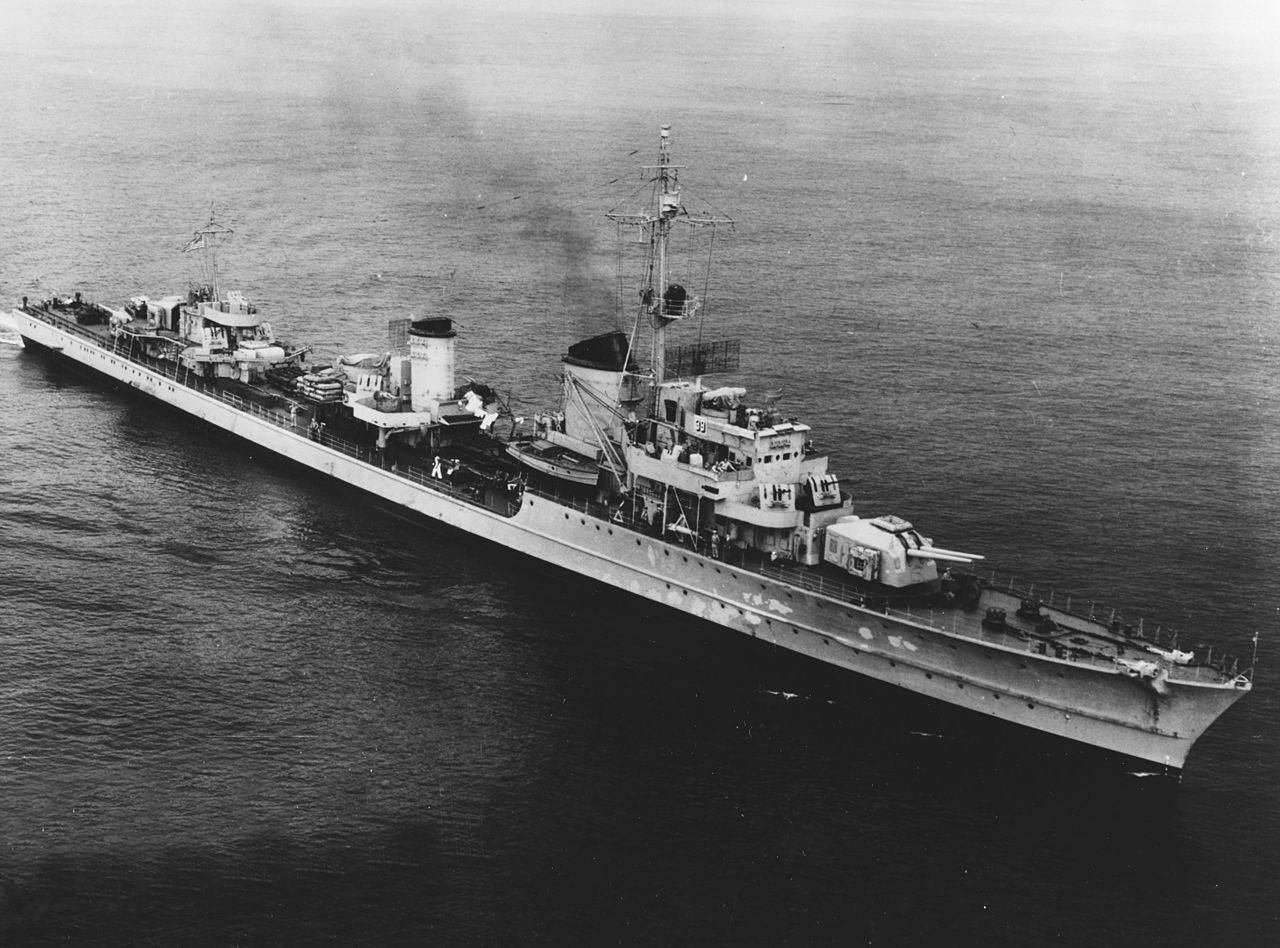
Design History
Final design
The Z23 class or Type 1936A evolved from the Type 1934 and 1934A, then 1936, and the next step after initial seaworthiness issues were corrected with new prows and bow shapes and flare, a workable transom stern, Saukeil and counterkeels they were a repeat of the previous class with unfortunately repated the same machinery of their precedessors. Whichg was troublesome to say the least. Their armament was howeve pushed to a step above to compensate their numerical inferiority by individual superiority, a credo of the Kriegsmarine under Raeder, also applied to the Hipper class cruisers and Bismarck class battleships. They were the perfect escorts, capable to out-gun and out-run their British opponents and be usable as commerce raiders if needed.
In terms of armament, they were closer to light cruisers indeed and repeated the 1917 concept of “flotilla leaders” already armed with 15cm (6 inches) which trigerred a “destroyer scare” in the admiraklty and pushed for better flotilla leaders such as the Thornycroft and Admiralty class (otherwise known as the Shakespeare and Scott class). The use of 15 cm (5.9 in) guns was atypical of destroyers as they were considered heavy and a soyrce of top weight unbalanace. They were avoided as to make the ships unstable despite the benefit of a large range and hitting power. They were also slower to reload and less well suited for the quick syle of combat which uusually suited destroyers. In any case, the upgrade was seen worth it. For these, a new type of light twin turret was developed, which went a long way, already a scaled down version of the twon turrets used for the Hipper class cruisers and intended for the Spähkreuzer or “scouts” instrumental in plan Z.
Each of these would have been given three twin turrets, one forward, two aft superfiring, like the K class cruisers, lower to avoid stability issues. With six 15 cm and the same torpedo armament as a destroyer, plus optional seaplane carrying capacity, they would have been ideal reconnaissance vessels, faster than light cruisers and capable to outclass any encountered destroyers.
The six Spahkreuzer Type 1938 were however cancelled after they were ordered in February 1941. Theu turrets were then freed to equip the Type 1936(mob) destroyers as they were bottlenecks in production at the time. Indeed these two turrets intended for the Type 1936A were not ready in time, so a single mounted gun forward wa used instead, reducing them to 4-guns.
So the 1936A type was an enlarged version of the 1936 type, designed to carry a heavier armament of five 150 mm initially. These boats are often referred to as the ‘Narvik’ class, which is incorrect, the assumption coming from the fact that some of these boats formed the 8th Destroyer Flotilla (“Narvik”) between 1 December 1940 and August 1944. As the C38 twin turret was delayed by production difficulties, the class was completed with a single 150mm mounting ona ‘bandstand’ in ‘A’ position; when the turret became available it replaced the single gun in Z23, Z24, Z25 and Z29, Experience proved the 150mm gun to be less than satisfactory since the ammunition had to be handled as separate shells and powder-cartridges as against the single cartridge of the old 127 mm weapon. Moreover, at 97 tons the twin turret was so heavy that the boats’ sea-going capabilities suffered.
Construction
Hull and general design
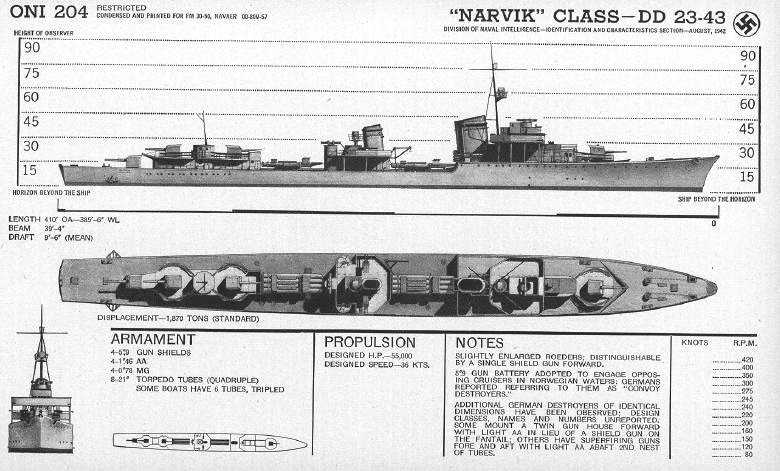
“Narvik” class ONI blueprint
The 1936A type destroyers were larger than previous classe,s notably due to the buoyancy reserve and stability issues that were planned to carry 15 cm guns. They ended at 2,543–2,657 long tons (2,584–2,700 t) versus 2,411 long tons in standard displacement, 3520-3590t fully loaded versus 3,415 long tons (3,470 t). They were longer at 127 m (416 ft 8 in) overall versus 123.4 meters (404 ft 10 in) for the initial Type 1936 and 125.1 meters (410 ft 5 in) from Z20 onwards with the new clipper bow. In Beam they reached 12 m (39 ft 4 in) instead of 11.75 meters (38 ft 7 in) and had a slightly deeper draught at 4.38–4.65 m (14 ft 4 in – 15 ft 3 in) instead of 4.5 meters (14 ft 9 in). More recent data showed they displaced betwen 3,519–3,691 long tons (3,575–3,750 t) at deep load. Their stability was slightly degraded and seems no to match the previous Type 1936 metacentric height of 0.95 meters (3 ft 1 in) deeply loaded.
Protection was absent but they were heavily compartimented, with a subdivision below the waterline into 16 watertight compartments, one more than for the previous class. They were fitted with a double bottom that covering 47% of their length amidships. The seven compartments amidships contained the massive propulsion and auxiliary machinery. They had dropped the planned active stabilizers to reduce roll and instead had trusted bilge keels fitted in 1940. They crews amounted to 11–15 officers and 305–20 sailors and as flagship they had 4 extra officers and 19 sailors. If the bridge general outlook was unchanged, internal shapes were modified and accomodations made more spacious.
They still repeated the style of the 1934A and 1936, again with an effort to contain the superstructure to regain stability. At leas the forward section ended abruplty forward of the bridge due to the initially intended twin turret which needed to be as close as the bridge as possible to reduced excessive forecastle topweight. Despite of thise, they were known, when firredt with the twin turret, to plough heavily in heavy weather. Only the increase bow flare contained this a bit. The ealier Type 1936A which had a single gun on banstand fared much better.
The bridge instead of a three-faceted section wa snow flat, creating a “cross” by the wings extensions, with still an open roof bridge above, a small structure aft to house and support the fire control. next came a raked tripod mainmast and large main funnel in which were truncated four exhausts for the two forward pairs of boilers, capped. Next came the first torpedo tube bank and amidship structure with the aft raked funnel (axhausting the aft pair of boilers) also with cap. The aft searchlight was on a platform right behind it and second forward being placed high up on the mainmast primary pole, supporting the spotting top and radio cables down to the aft half-mast.
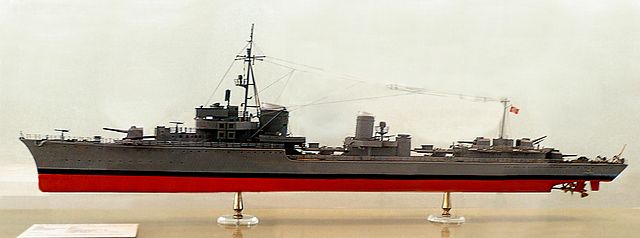
Yard model of the 1936A type
The torpedo tubes bank was followed by the rear quartedeck house supporting the three 15 cm single turrets X, Y and Z, the latter on deck whereas X faced forward. In between X and Y was located the radio small house and on its tip a platform with 37 mm FLAK guns. Seen from the top, the bridge had broad open wings forming making a rectangle with with rounded forward corners, supported by pillars on the beam either side and ending in a triangle and flat section aft. As for the previous class, the first fire control post was on top pof the bridge, the second was located aft of the amidship structure and funnel.
The hull had a clipper bow, much flare forward and a beam profile gradual with only a limited flat section amidship and a broad transom stern. The entire deck was all-metal, with wood used on the bridge’s wings and upper open bridge deck. They carried four boats, two admiralty motor cutters abreast the main funnel, two pinnaces located on deck under the wings of the amidship structure. Life rafts were installed on the sides of upper turret shields, and the bridge’s wings.
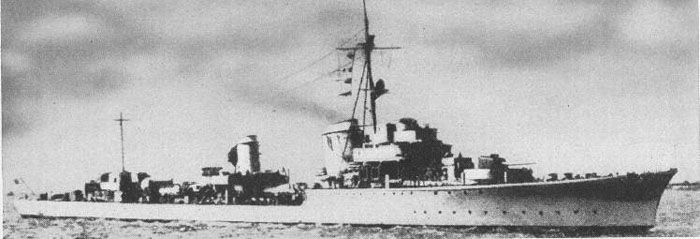

Unidentified 1936A destroyer shortly after completion, booklet for identification of ships, published by the Division of Naval Intelligence of the Navy Department of the United States.
Powerplant
The Type 1936A destroyers repeated the same powerplant as for the 1934/1934A/1936 types with two Deschimag instead of Wagner geared steam turbine sets driving each a single three-bladed 3.25-meter (10 ft 8 in) propeller. Steam came from six high-pressure Wagner water-tube boilers, each fitted with superheaters in order to operate at a working pressure of 70 atm (7,093 kPa; 1,029 psi) with a temperature of 450–480 °C (842–896 °F). This ensemble was designed for an ouput of 70,000 metric horsepower (51,000 kW; 69,000 shp). Top speed was rated for 36 knots (67 km/h; 41 mph). Some exceeded this figure on trials, reaching 39–41.5 knots (72.2–76.9 km/h; 44.9–47.8 mph) on light load going up to 76,500 shp (57,000 kW or 77,600 PS).
Whehen their boilers were cold, to power AA and other systels they had like the previous ships a pair of 200-kilowatt (270 hp) turbogenerators and two 80-kilowatt (110 hp) diesels, then a single 40-kilowatt (54 hp) diesel generators located in the amidship section. The Deschimag turbines proved more reliable than the Wagner ones. Both the standard and mobilization types had the same sets.
This was due to the early batch being built at Deschimag of Bremen from Z23 to Z26 and the rest, including the Mob types, at Germiawerft in Kiel.
As for range, the previous class carried a maximum of 739 metric tons (727 long tons) of fuel oil for 2,050 nautical miles at 19 knots, quite an improvement over the 1934A (1,825 nmi) and after stability concernes were solved, they could carry their full load. The 1936A class carried variable amounts, but above this: Z23, 24, 25, 26, 27 carried 791 tonnes, whereas Z28 carried 804 tonnes and Z29 carried 825 tonnes. As a result, they could treach between 2500 nm to 2950 nm for Z29 and Z30, and 2900 for Z28. As for the Mobilization type, they were based on the latter design and could carry 825t of oil for 2,950 nautical miles, still at 19 knots.
Armament
 Like the 1934/34A the 1936 or Z17 class had five main guns, eight AA guns, two quadruple torpedo tubes and 60 mines. They were not designed for ASW work at all, that is until modified. Admiral Erich Raeder designed their armament back in 1933 asking for five guns instead of four (the same as British and French flotilla leaders) and quadruple TTs instead of triple banks.
Like the 1934/34A the 1936 or Z17 class had five main guns, eight AA guns, two quadruple torpedo tubes and 60 mines. They were not designed for ASW work at all, that is until modified. Admiral Erich Raeder designed their armament back in 1933 asking for five guns instead of four (the same as British and French flotilla leaders) and quadruple TTs instead of triple banks.
The five main guns were shielded 12.7 cm (5 in) SK C/34 guns in single mounts covered by gun shields: Superimposed pair A-B forward, same aft, plus the 5th mount positioned on top of the rear superstructure, facing forward. They carried also 600 rounds of ammunition in all.
AA defence comprised four 3.7 cm (1.5 in) SK C/30 anti-aircraft guns in single mounts like for the previous type 1934, 8,000 rounds shared between them. Two were located aft on the upper structure between the N°3 and N°4 mounts, plus six 2 cm (0.79 in) C/30 anti-aircraft guns in single mounts and 12,000 rounds total. This was rounded by the two quadruple torpedo tubes banks, so eight 53.3 cm (21 in) torpedo tubes in all, mounted amidships. This was completed by depht charges and mines.
15 cm TbtsK C/36
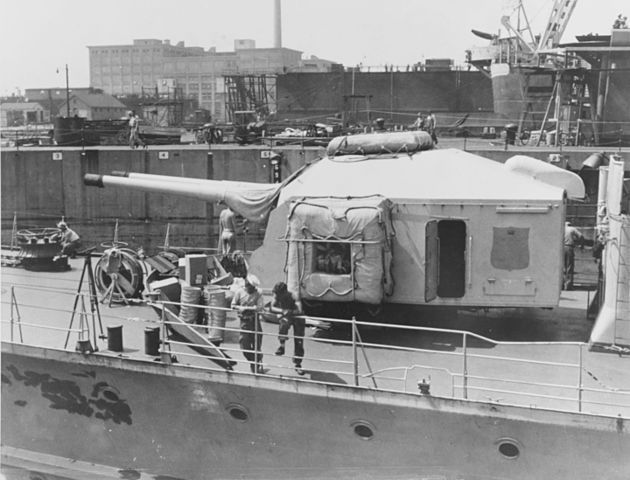
This particular gun was originally developed to replace the 12,7 cm on the first generation of Kriegsmarine’s destroyers Z27 by decision of the Oberkommando des Marine under Raeder. However the 15 cm TbtsK C/36 originally was to be given to torpedo boats until studies proved it could be installed on destroyers, even rearming the Type 1934 and 1934A destroyers that were just about to be commissioned. The new Type 1936 destroyers were planned to have the new gun, and a first ship, Z8 Bruno Heinemann had all its 12.7 cm main guns replaced by experimental 15 cm TbtsK C/36 guns in 1938 howing that they were not ready, between loading issues and too heavy mountings. Z8 was dangerously topweight and nearly capsized when manoeuvering, even after one upper 15 cm guns was removed, and her old battery was reinstalled.
It was one of the first funs to have a muzzle heater to prevent icing up in freezing temperatures but it was power hundry and strained the elevating gear. The gun cradle had two massive hydraulic buffers to absorbe 58 tons (128,000 lb) of recoil and a pneumatic recuperator. Both training and elevation were in manual or electric modes and controlled by hydraulic handles with a left side gunner both training and elevating the gun with a backup right side gunner that could take control at any moment. It also had an electromagnetic and mechanical triggers with foot pedal or right hand-wheel but the gun could also be fired remotely from the conning tower. Its stereoscopic sights had a 5x 10x zooms. The right gunner usually concentrated on elevation focus with sets of compensating gears. Firing data came from the FCS via wire and both gunners had a an intercom receiver with headgear.
The Gun houses varied between the C/36 single turret and twon turrets.
The C/36 single gun house weighted 18,800 kg (41,400 lb) overall including 4,153 kg (9,156 lb) for the gun shield alone. On the 1936A/mob types using the five C/36 mounts, ‘A’ could train from 30° to 0° to 330°, ‘B’ from 40° to 0° to 320°, ‘C’ from 20° to 0° to 340°, ‘D’ from 27° to 0° to 333°, ‘E’from 42° to 0° to 318°, depressed –10°, elevated to 30°.
Their splinter-proof shield did not cover the rear and loaders were exposed, but the gunners were protected by 10 mm (0.39 in) front, 6 mm (0.24 in) sides and roof and there were two closable flaps for sighting ports forward and there were four inspection flaps to be serviced. The main gear was electric, via the ship’s generators so to be usable when the machinery was cold with an 1 kilowatt (1.3 hp) permanent and 3 kW (4.0 hp) peak output plus auxiliary lighting. The Type 1936A rarely had all the five single guns. Z28 for example, only had four in superfirong positions fore and aft, “Q” gun being removed and flagship facilities installed in place. The majority had a single forward gun for stability, on a low shielded bandstand to deal with waterspray on the forecastle.
The DrhL C/38 twin turret were originally designed for the three O class battlecruisers and spähkreuzer, all cancelled. So they were recycled into the Type 1936A destroyers originally. Delays however had the “mob” equipped instead and the single guns, instead of rearming the Type 1936, went on the Type 1936A. The hom was that this forward twin turret lowever the top weight while raising back the number of effective guns to fiv. But the turret proved too heavy by itself. Two 15 cm TbtsK C/36 guns were shoehorned into this “lightweight” or “compact” DrhL C/38 twin turret using extensive melding, but it was still twice as heavy as a C/36 mask. Its integration into the existing fire control system was not smooth either. Plans to mount two on new destroyer such as the 1936B went to nowhere, and eventually 128mm/45 DP turrets were chosen for the Type 1936C. In the end, only Z23-25, Z29 of the Type 1936A and Z31-34, Z37-42 of the Mob type were so equipped, so a majority of the latter. Quite often, “Q” single turret was landed to make way for extra AA in wartime.
The C/38 turret was elevated by an electrically powered Pittler-Thoma hydraulic gear with manual backup. Internal design however was near-identical to the C/36 so most parts were shared. They had for example the same Ardelt electric ammunition hoist with ten ready rounds at the rear of the turret for short engagements, kept in airtight aluminum containers locked in galvanized steel boxes.
The C/38 was a 60.4 t turret, which was indeed quite hefty and obliged engineers working on the 1936A design to plan for extra barcing under the forecastle early on. The shield accounted for 13,750 kg (30,310 lb) alone, but gunners were protected by 30 mm (1.2 in) forward 20 mm (0.79 in) on both sides, 20 mm on the roof, 15 mm (0.59 in) on the rear. This was a substantial advantage over the single guns. Barbette diameter was 3.2 m (10 ft) and the guns recoiled 44 cm (17 in) inside the shield. They were separated by 1.07 m (3 ft 6 in) so simultaneous fire was delayed to avoid interference causing innacuracy. They could be at 8°/s up to 65° thanks to the open barbette, unlikle single guns, and so in theory “dual purpose”. In reality they were way too slow for this, lacked both the shells and fire control for any AA use. This however favored the range.
Specs:
It had a total Mass of 7,200–8,564 kilograms (15,873–18,880 lb) per mount (not the full twin turret) for 7.165 meters (23.51 ft), 6.815 meters (22.36 ft) barrel alone.
It fired a 45.3 kilograms (100 lb) separate-loading, cased charge 14.91 centimeters (5.87 in) actual diameter.
The Breech used a horizontal sliding-block system and the C/36 single mount could elevate +30°, the C/38 Twin mount to +65°.
It was relatively slow at 8 rpm max with a 835 meters per second (2,740 ft/s) velocity, 21,950 meters (24,000 yd) at 30° for the C/36 and 23.55 kilometres (14.63 mi) range at 47° for the C/38 mount.
The anti-aircraft armament (FLAK) comprised at first the following:
-Four 3.7 cm/80 SK C/30 (1.5 in) anti-aircraft guns in two twin mounts (8,000 rounds of ammunition)
-Five single 2 cm/65 C/38 (0.79 in) anti-aircraft guns, single mounts (12,000 rounds of ammunition).
It should be said that the mounts were stabilized, but their gyroscopes were undersized and could not cope with sharp turns or heavy rolling.
3,7-cm/80 Schnelladekanone C/30

The C/30 was a semi-automatic anti-aircraft gun automatic ejection of spent cartridge casing but hand-loaded one round at a time for up to 30 rounds per minute. It was well below the Bofors 40 mm whereas its muzzle velocity was 12-15% higher with better aiming. It was ubiquitous in the Kriegsmarine.
Specs:
Mass: 243 kgs (536 lb), 3.074 metres (10 ft 1 in) long, 2.962 metres (9 ft 9 in) L/83 barrel
Fired a fixed, 0.68 kilograms (1 lb 8 oz) cased charge shell 37 x 380 mm R
The breech was a semi-automatic, vertical sliding-block type allowed 30 rpm (practical)
Muzzle velocity was 1,000 m/s (3,300 ft/s) 2,000 m (6,600 ft) effective ceiling and 8,500 m (9,300 yd) at 37.5° max.
2-cm/65 Schnelladekanone C/38
The rival to the allied oerlikon, this ordnance was developed and manufactured by Rheinmetall, a design linked to the earlier Solothurn ST-5 and declined int the C/30 and the C/38, both fully automatic. The C/30 was prone to jamming using a 20 rounds magazine with frequent pauses for reloading. The C/38 had a short recoil and the same 20-round magazine with a later 40-round magazine introduced, more reliable overall. The Navy mount was a tri-axial quad system develped for the C/30 guns with layer and pointer in front, cross-roll operator behind (Flakvisier 35 gunsight) and later evolved into the 2 cm Flak C/38 auf Vierlingslafette C/38 with a simplified bi-axial quad mounting (Flakvierling 38) operated by a single gunner behind. But these were single mounts in the earlier case, with c/38 guns here. Later Flakvierlings were installed (Barbara upgrade)
Specs:
C/38 weight 129 lbs. (57.5 kg) oa lenght 88.7 in (2.2525 m) barrel 51.2 in (1.300 m)
Rate Of Fire 480 rounds per minute cyclic, 220 rounds per minute practical
0.71 lbs. (0.320 kg) round, either AP-T 0.326 lbs. (0.148 kg), HE-I 0.265 lbs. (0.120 kg) or HE-T 0.256 lbs. (0.116 kg)
Complete round 8.99 in (22.8 cm) with 0.265 lb. (0.120 kg) RPC/38 propellant, Brass, 20 x 138B mm, 0.41 lbs. (0.186 kg)
Muzzle Velocity from 2,625 fps (800 mps) to 2,870 fps (875 mps) with HE-T.
2,000 rounds stored for each in 20-rounds mags (200 mags).
FLAK: Barbara upgrade
Project Barbara was an attempt from 1942 to improve the anti-aircraft capabilities of its ships at at forst simply consisted in having extra 20 mm (0.787 in) anti-aircraft guns added wherever possible, as they were light and did not compromised stability too much. In 1944 a sub-project concentrated on destroyers for the installation of 3.7 cm Flak M42 anti-aircraft guns. In mid–1941 it was also decided to swap 37 mm to the new 40 mm (1.575 in) or 50 mm (1.969 in) guns and notably to use the newly developed 5.5 cm Flak Gerät 58 anti-aircraft guns in development. They could fire a 2 kg (4.4 lb) at 120 or 150 rounds per minute, gas operated and using a triaxial or quad-axial mount to be fully stabilized in all conditions, making it valuable especially on unstable platforms such as destroyers. This never reached fruition however and instead 20 mm (0.787 in) were to be replaced by 30 mm (1.181 in) guns, and this too, was never done.
Instead it was commonly decided to remove “Q” turrets and install Flekvierlings (quad 20 mm mounts) instead. Z23-25, 27, 29, 30 for example all received one, and Z24 ahd even two. Otherwise, it was common to mix single, twin 37mm/57 FlaK M/43, and twin 20mm/65 C/38 mounts. Radars were also improved but fire control remained problematic.
Torpedoes
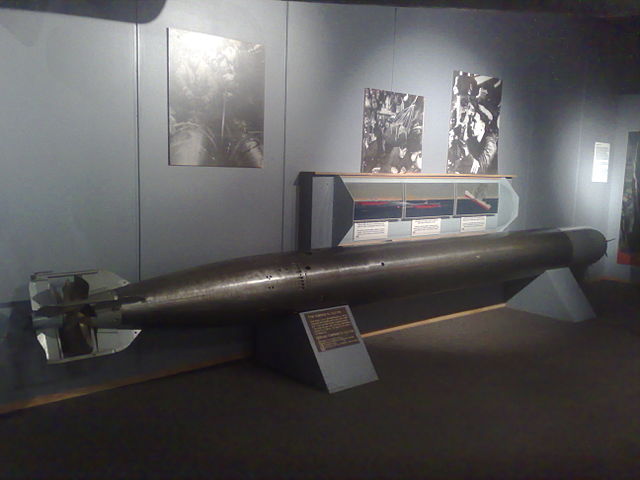
They had eight 53.3 cm (21 in) torpedo tubes, in two quadruple, centerlined in electrically power-operated mounts. They had reloads, obut only four torpedoes, two for each bank.
They were of the 1934 53.3 cm (21″) G7a T1 “ato” class. read more
⚙ specifications TORPEDO |
|
| Weight | 3,369 lbs. (1,528 kg), Negative Buoyancy 605 lbs. (274 kg) |
| Dimensions | 23 ft. 7 in. (7.186 m) |
| Propulsion | Decahydronaphthalene (Decalin) Wet-Heater |
| Range/speed setting | 6,000 m/44 knots, 8,000 m/40 knots, 14,000 m/30 knots |
| Warhead | 617 lbs. (280 kg) Hexanite |
| Guidance | Federapparattorpedo; 1944 Lagenunabhängiger Torpedo |
Mines
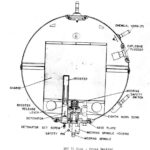 Each of the 1936A and (mob) had mine rails fitted fitted on the rear deck with a capacity of sixty mines total. They are assumed to be the EMC Contact Mines placed on trolley rails. These were spherical mines 44 inch (1.12 m) in diameter and with an explosive load of 661 lbs. (300 kg). Detonation was trusted to seven Hertz horns. These mines could be moored underwater, under 55, 109, 164 or 273 fathoms (100, 200, 300 or 500 m). First captured by the British in October 1939. more on navweaps.com/
Each of the 1936A and (mob) had mine rails fitted fitted on the rear deck with a capacity of sixty mines total. They are assumed to be the EMC Contact Mines placed on trolley rails. These were spherical mines 44 inch (1.12 m) in diameter and with an explosive load of 661 lbs. (300 kg). Detonation was trusted to seven Hertz horns. These mines could be moored underwater, under 55, 109, 164 or 273 fathoms (100, 200, 300 or 500 m). First captured by the British in October 1939. more on navweaps.com/
ASW
Four depth charge throwers were mounted on the sides of the rear deckhouse, plus six racks for individual depth charges on stern sides. This was caluculated for two or four patterns of sixteen charges each. They also came out with the ‘GHG’ (Gruppenhorchgerät) passive hydrophones, fitted underneath the hull, to detect submarines.
These four stern Wasserbombenwerfer C/35 depth charge projector located on the broadsides close to the freeboard to clear mine rails fired a Rheinmetall 606 lbs. (275 kg), initial velocity of 115 fps (35 mps) and an arbor weight of 77 lbs. (35 kg). In total they could carry as high as 64 depth charges charges.
Fire Direction and sensors
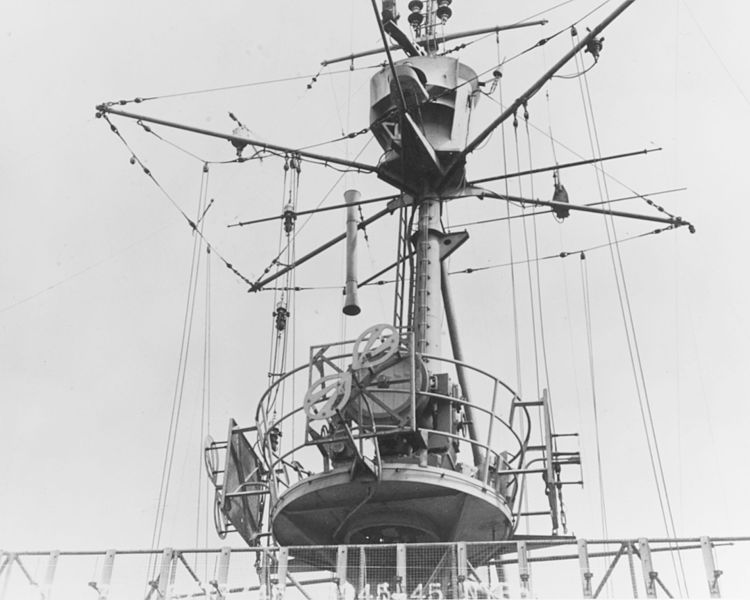
The Type 1936A had the same fire control systems as for the Type 1936, located over the bridge and aft on the amidship structure. They consisted in a large telemeter connected to a ballistic calculator. Data was transmitted to each gun via intercom and indicators to coordinate fire on a single target at once. However they were completed also with radars.
FuMO 21 radar
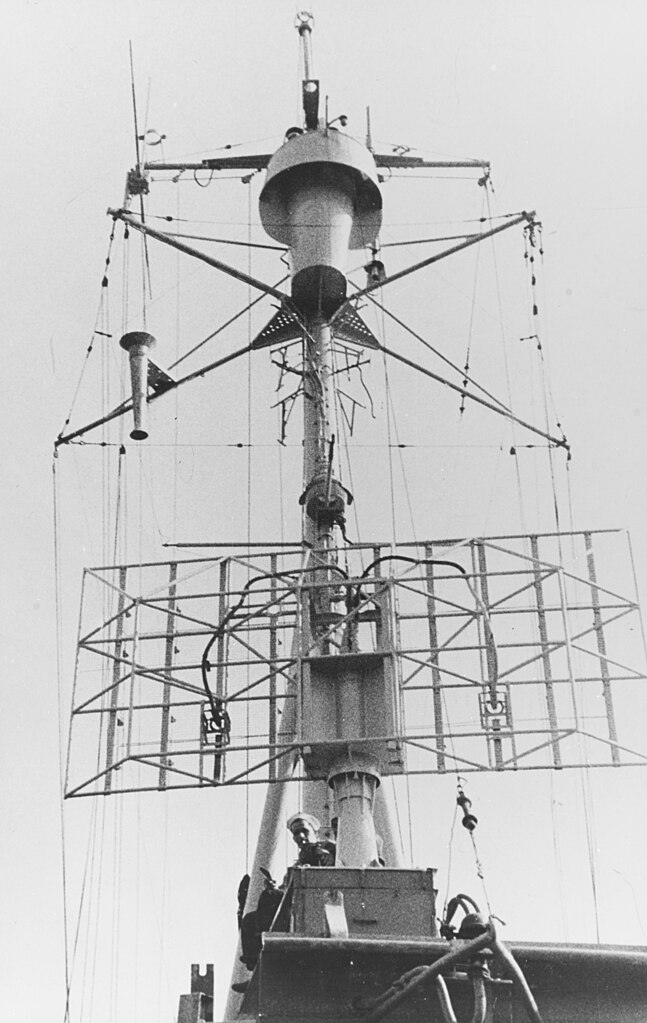
The FuMO 21 (Funkmess-Ortung, “Radio-direction finder, active ranging”) designed in 1941 became the main search radar installed from light cruiser down to torpedo boats. It was derived from the Seetakt search radar with a bedframe antenna 2 m × 4 m (6 ft 7 in × 13 ft 1 in). Range was quite limited however and beyond the range of capital ship gunnery. But it was of some use for close encounters by night and fog.
Specs:
Frequency 368 MHz/81.5 cm, PRF 500 per second (8 kW power)
Pulsewidth 5 μs, Range 10 nmi (19 km; 12 mi) prec ±70 m (230 ft)
FuMO 24 radar
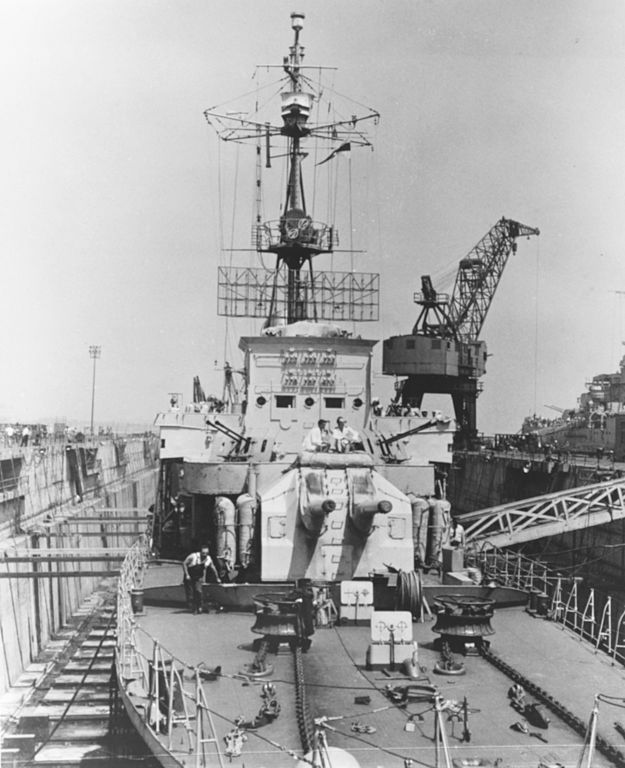
This upgraded system was installed from 1944. it was designed and ready by 1943. It had a larger bedframe antenna 2 x 6-meter (6 ft 7 in × 19 ft 8 in) and slightly better range.
Specs: 8 kW, Frequency 368 MHz/81.5 cm, PRF 500 per second, Pulsewidth 5 μs
Range: about 12 nmi (22 km; 14 mi) prec ±70 m (230 ft)
FuMB 3 Bali ECM suite
The first serial ECM suite on Kriegsmarine ships, it consisted of a cylindrical bedframe antenna located atop the main battery director. On larger ships ideal combinations were of the FuMB 9 (W. Anz.g.2), FuMB 4 (“Samos”) and the FuMB 10-FuMZ 6 (Borkum-naxos combination) search receivers.
In general these symmetrically fed broadband round dipole had a range around 90 to 500 MHz and were pressure-waterproof with towering rods receiving vertically polarized waves. In this case, the dipole halves are short-circuited on the receiver side and used as a counterweight for the support mast. FuMB 3 was also mounted on submarines.
FuMB 6 Palau ECM suite
A complementary, larger set. This antenna was placed on the foremast spur above the Fumo 21/24 bedframe radar. The masthead top had the lighter FuMB 3 Bali.
In 1944 usually a FuMO 63 Hohentwiel-K replaced the aft searchlight on its platform, and a FuMB 6 Palau on a yardarm was found of the foremast with a passive array consisting of four fixed Sumatra dipoles situated around the forward searchlight sponson.
S-Gerät sonar
This device could be inclined 80 up and down and also sideways and was stated to have a range of 400 metres. This was the standard light sonar common to light vessels and U-Boats.
GHG hydrophone
The GHG for “Gruppenhorchgerät” was originally designed for U-boats and included two groups of 24 sensors each with its own tube preamplifier for frequency signals routed to a switching matrix in the main unit. The sonar operator could then detect exact direction of the sound source. Often three switchable crossover with 1, 3 and 6 kHz center frequency were used. it had a dead zone fore and aft however and a range of 20 km. The Resolution was below 1° at 6 kHz, 1.5° at 3 kHz, and 4° at 1 kHz without crossover of 8°.
Appearance

Z30, 1936A type
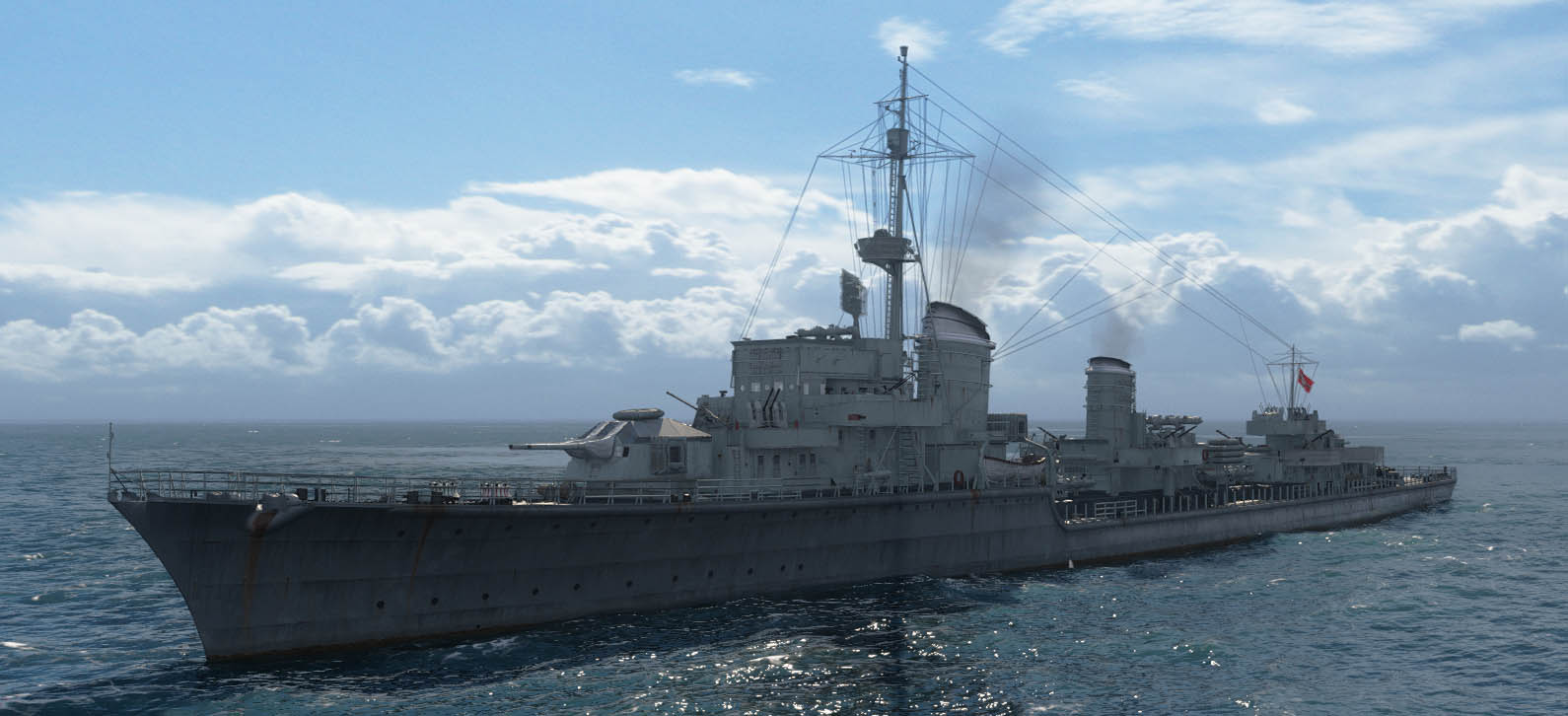
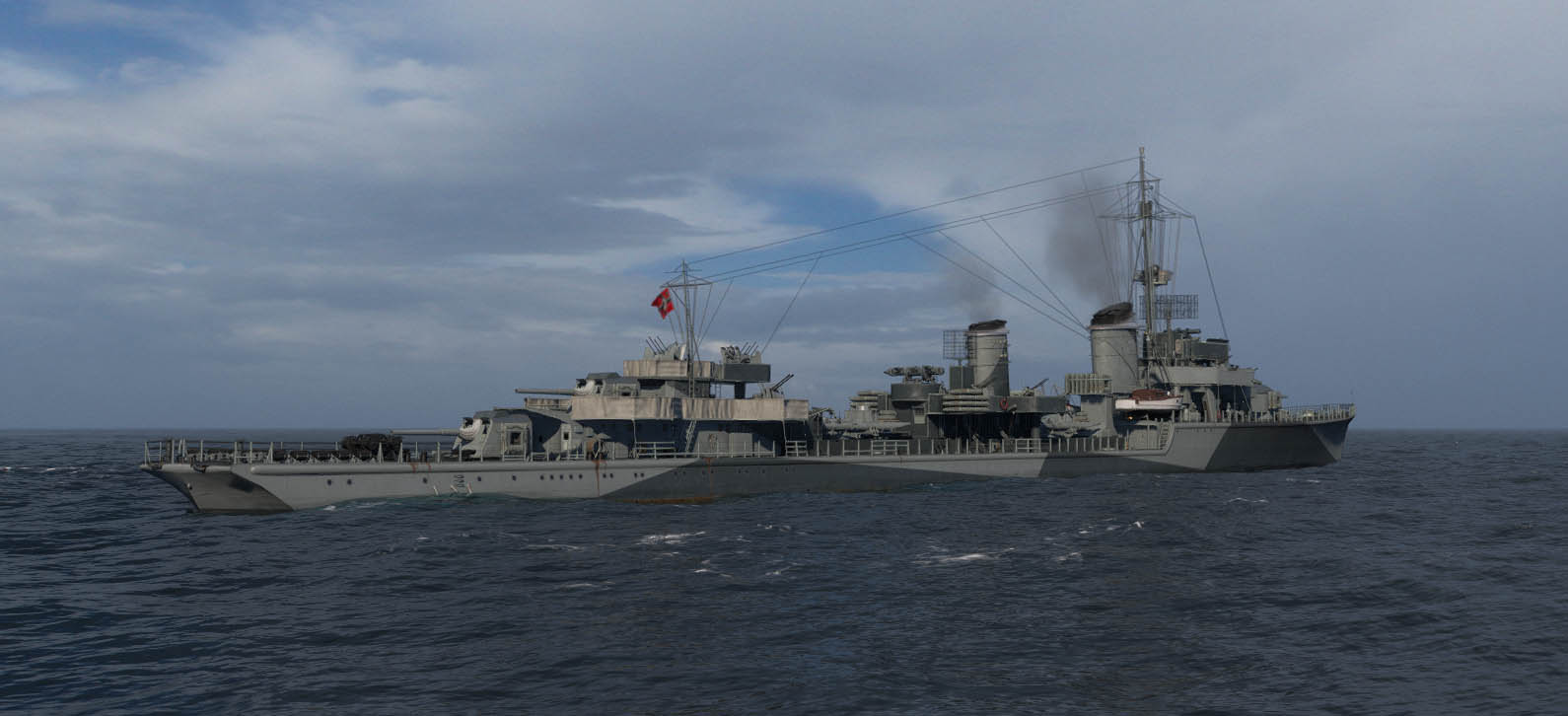
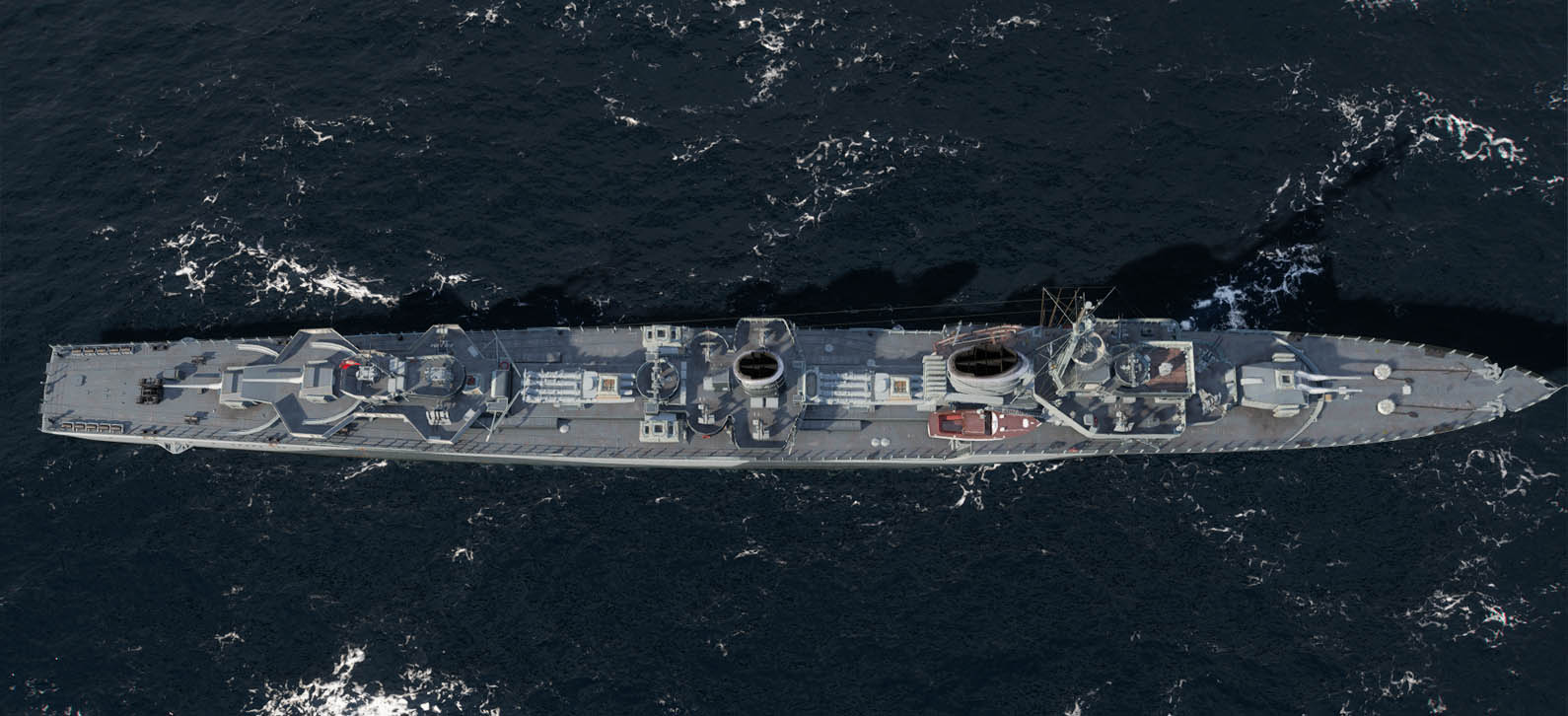
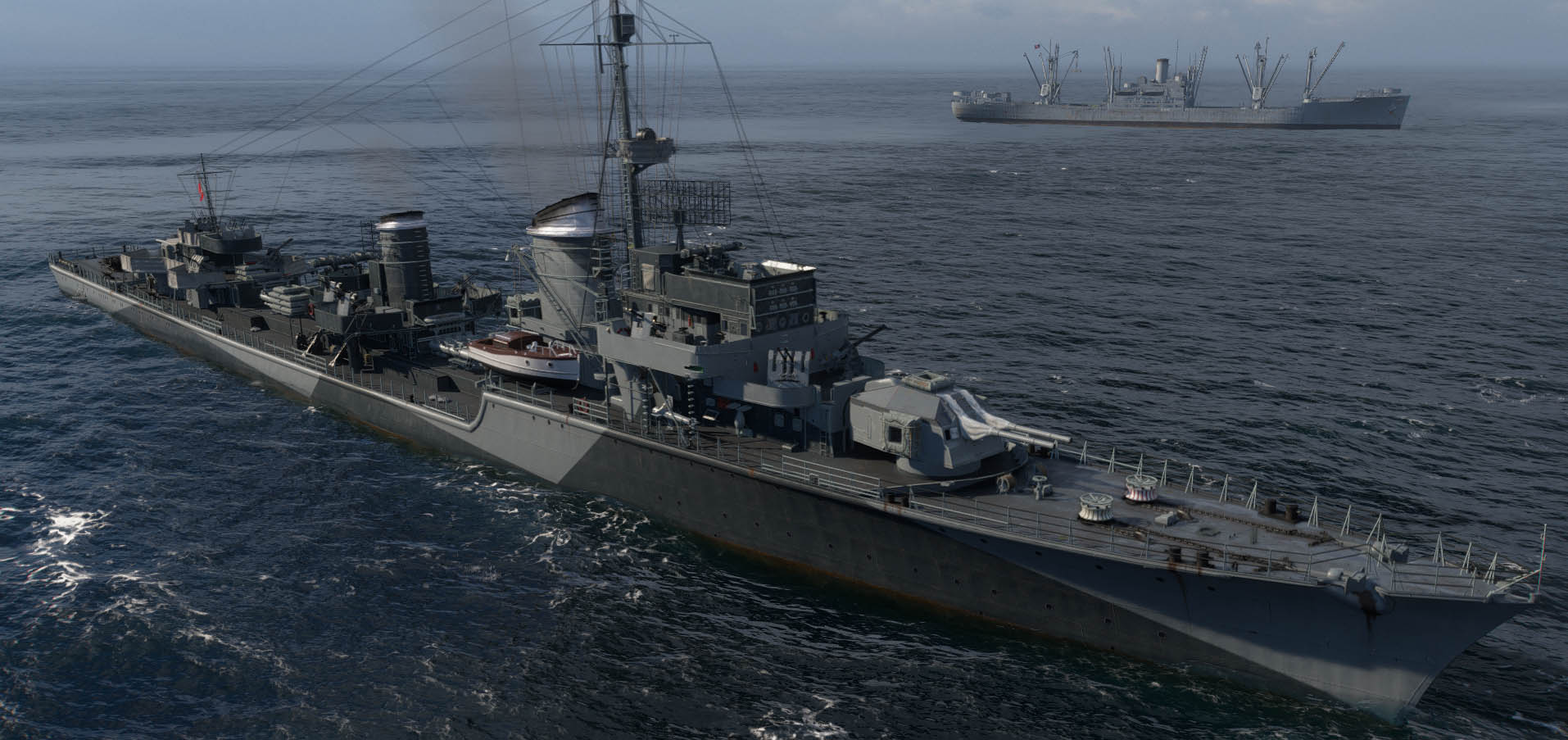
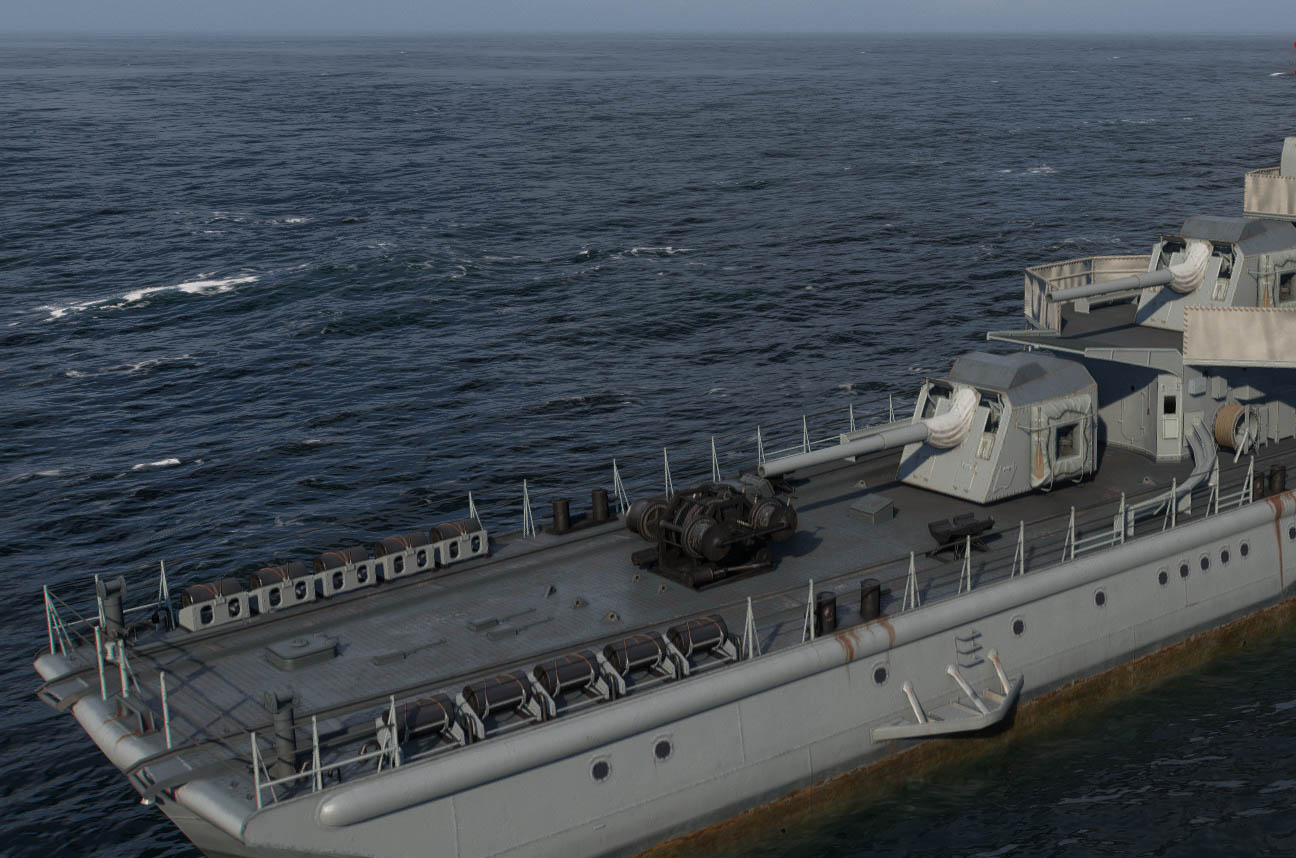
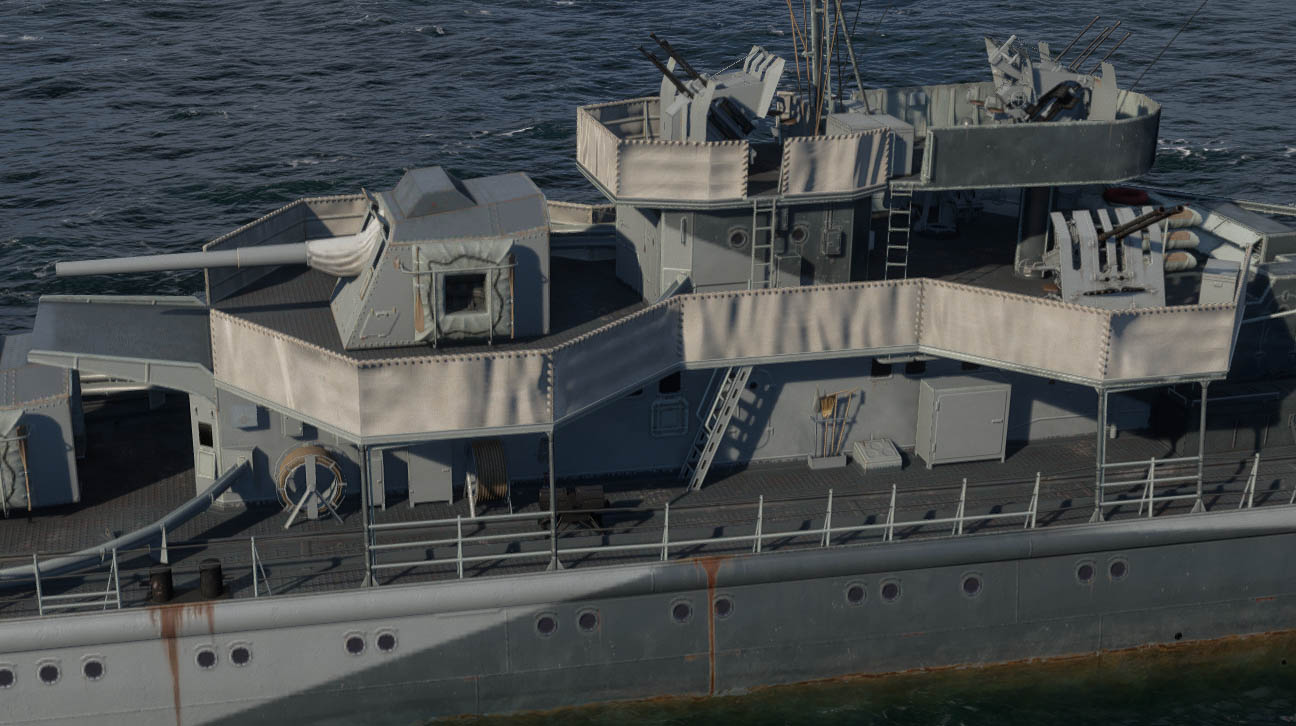
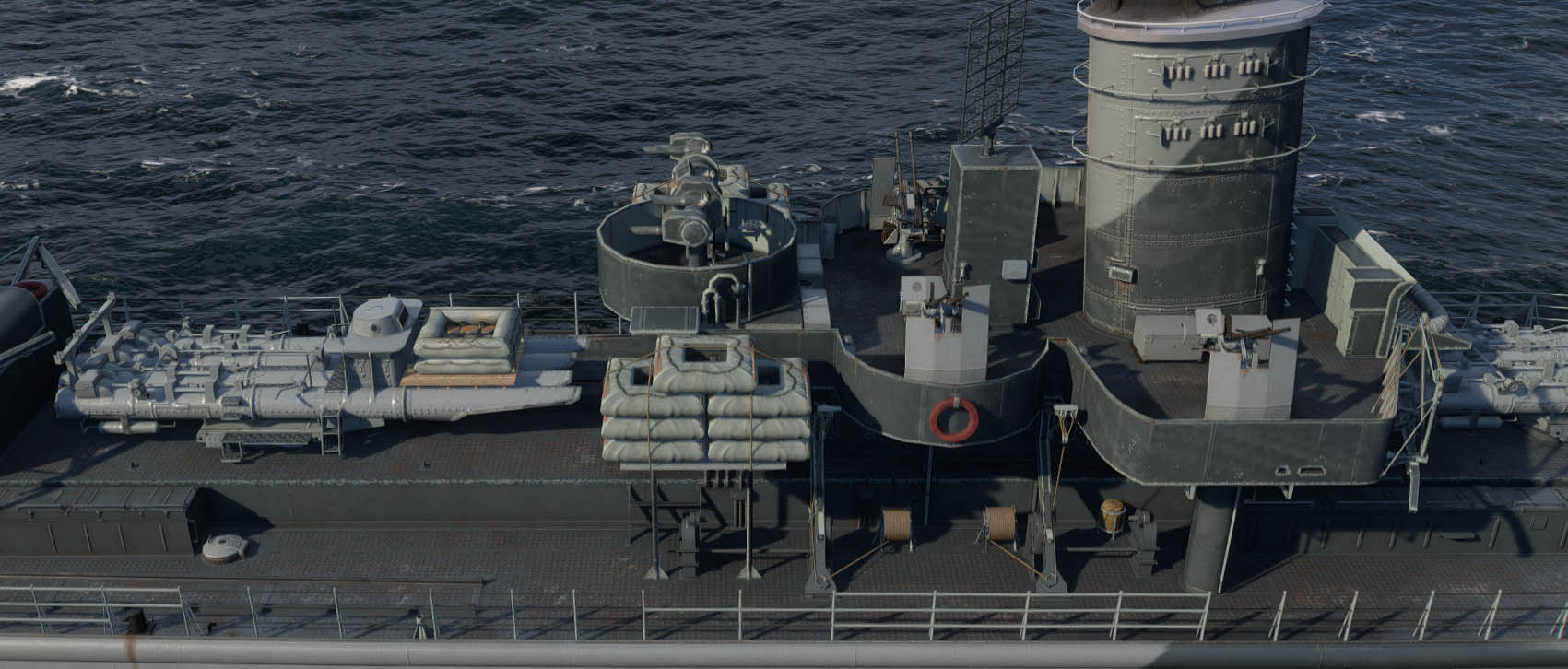
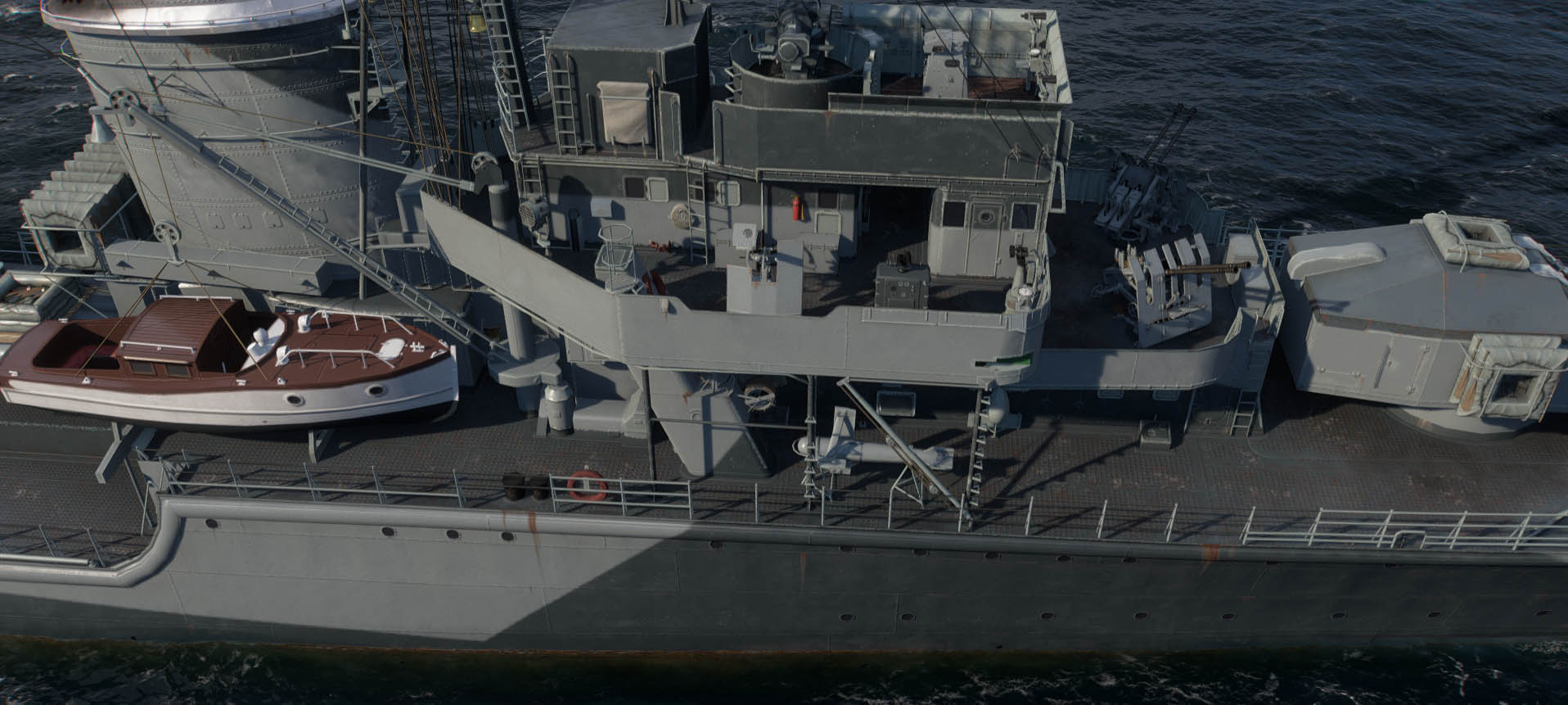
WoW view of Z31 of the 1936 Mob type.

Z24 in 1942, the twin turret version
⚙ specifications Z23 |
|
| Displacement | 2,411 long tons standard, 3,415 long tons deep load |
| Dimensions | 123.4/125.1 x 11.75 x 4.5 m (404 ft 10 i/410 ft 5 in x 38 ft 7 in x 14 ft 9 in) |
| Propulsion | 2× shafts geared steam turbine sets, 6× water-tube boilers 70,000 PS (51,000 kW; 69,000 shp) |
| Speed | 36 knots (67 km/h; 41 mph) |
| Range | 2,050 nmi (3,800 km; 2,360 mi) at 19 knots (35 km/h; 22 mph) |
| Armament | 5× 12.7 cm (5 in), 2×2 3.7 cm, 6× 2cm FLAK, 2×4 53.3 cm TTs, 4× DCR, 6× racks, 60× mines |
| Crew | 323 |
Combat Records
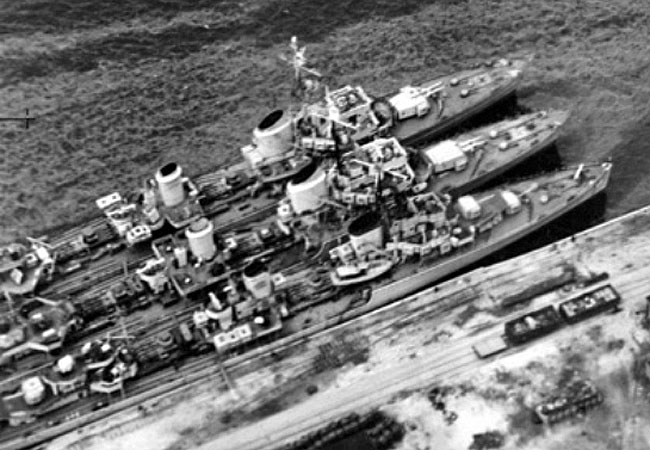
The class were laid down between November 1938 and April 1940 and commissioned between September 1940 and November 1941. Z28 was towed to Deschimag, Bremen, for final outfitting; as a staff destroyer she featured a revised superstructure aft, giving rise to the nickname ‘pullman car’. 230 carried a flying deck over her torpedo tubes for a period, this being removed in 1942-43. Z25 and Z29 were modified to ‘Barbara’ standards, with 12-37mm/83 M42 in single and twin mountings and 18—20mm C38 in M44 twin and C38M quadruple mountings.
Z23 was damaged by RAF bombing at La Pallice on 12 August 1944; decommissioned nine days later, she was eventually broken up in 1948.
Z24 was bombed by the RAF off Le Verdon and, although she managed to reach harbour, capsized at her berth.
Z25 was transferred to Great Britain after the war. On 2 February 1946 she was handed over to the French Navy at Cherbourg and renamed Hoche (D602). In reserve 1949-51, she was then refitted and modernised with a single 150mm gun in ‘A’ position, a German-type ‘Barbara’ AA configuration, French-type 550mm torpedo tubes, US-manufactured radar, Hedgehog, etc. On 16 October 1953 she recommissioned as a fast escort at Toulon and was used as an ASW trials ship. Decommissioned on 28 August 1956, she was finally stricken on 2 January 1958 and broken up between 1961 and 1962.
Z26 was sunk during a German attack on convoy PQ-13 by gunfire from the cruiser Trinidad and the destroyers Fury and Eclipse.
Z27 was sunk in battle with the cruisers Glasgow and Enterprise during an attempt to assist home the blockade-runner Alsterufer.
Z28 was sunk following RAF bombing at the Sassnitz Roads; she was broken up in shallow water in 1950.
Z29 was at Wesermiinde for refitting at the end of the war, and was ceded to the USA; she was scuttled in the Skagerrak loaded with poison gas ammunition.
Z29 was converted to ‘Barbara’ configuration in the spring of 1945, carrying 14-37mm/83 M42 in single and twin mountings and 13~20mm C38. Z33 and Z34 received AA guns from the foundered Lützow in April 1945: 4-40mm/70 Bofors, 2~37mm/83 M42 1×2, 420mm C38M (1 <4) and 4-20mm M44 (2x2)
Z30 was decommissioned on 14 May 1945 at Oslo following mine damage; ceded to Great Britain in 1945, she was towed to Rosyth, after which she was used for explosive trials and sunk.
As for the 1936A (mob), they were commissioned between April 1942 and August 1944, and part of the wartime mobilization building programme. The group differed from the earlier designs in having a curved cap on the forward funnel. Originally the group should only have comprised Z31 to Z34, but after the cancellation of the 1938B type destroyers the group was enlarged to include Z37-Z42 although in the event only Z37-Z39 were built.
Both Z32 and Z38 were towed to Deschimag, Bremen, for final outfitting. Z31 was completed with a single 150mm gun in ‘A’ position; in 1943-44 a twin turret was installed; and in 1945, following battle damage, a 105mm/45 C32 was fitted.
Z31 was transferred to the Royal Navy after the end of the war. She was handed over to the French Navy at Cherbourg on 2 February 1946, and entered service under the name Marceau. She was refitted and modernised between 1948 and 1950: a single 150mm gun was installed in ‘A’ position, and US manufactured radar and AA weapons were fitted. She served for a further three years and after a period in reserve was sold for scrapping in 1958. However, she continued to be used for some time as a floating jetty at Brest, not being finally broken up until the 1960s.
Z32 was shelled by the RCN destroyers Haida and Huron during the Allied invasion of Barfleur and was driven ashore at the Ile de Bas.
Z33 was ceded to Great Britain in 1945. In the summer of 1945 she was handed over to the Russians and renamed Provornyj, and after service in the Baltic was scrapped in 1960-62.
Z34 was heavily damaged following a Russian torpedo hit on 16 April 1945; ceded to the USA after the war, she was, however. scuttled in the Skagerrak loaded with poison gas ammunition on 24 March 1946.
Z37 was scuttled at Bordeaux and the wreck broken up in 1949. Z38 was transferred to the Royal Navy and renamed Nonsuch (R40) in the autumn of 1945; later known as D107, she was decommissioned in 1949 and sold for scrapping.
Z39 also went to the Royal Navy but on 11 July 1945 was handed over to the US Navy at Plymouth; transferred to Boston, she was used tor trials and in autumn 1945 was redesignated DD939, in late 1947 she was sold to France and towed to Casablanca, being hulked there from 1949 to 1951, then towed to Toulon and cannibalised for the French ex-German destroyers Kléber, Hoche and Marceau. Her remnants were scrapped in 1964.
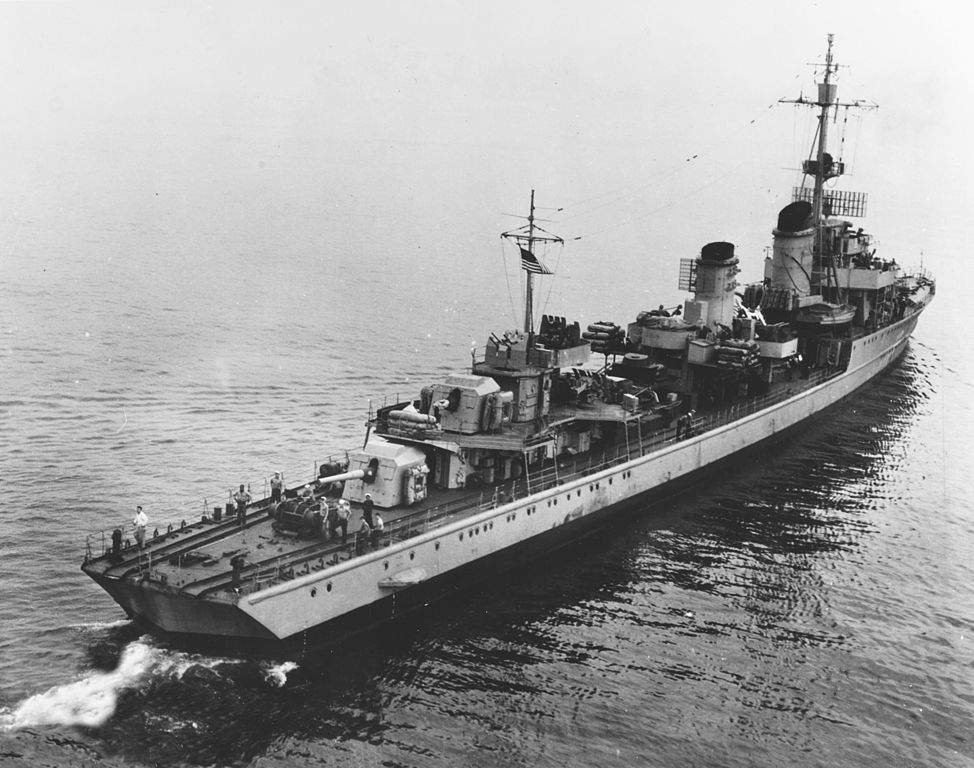
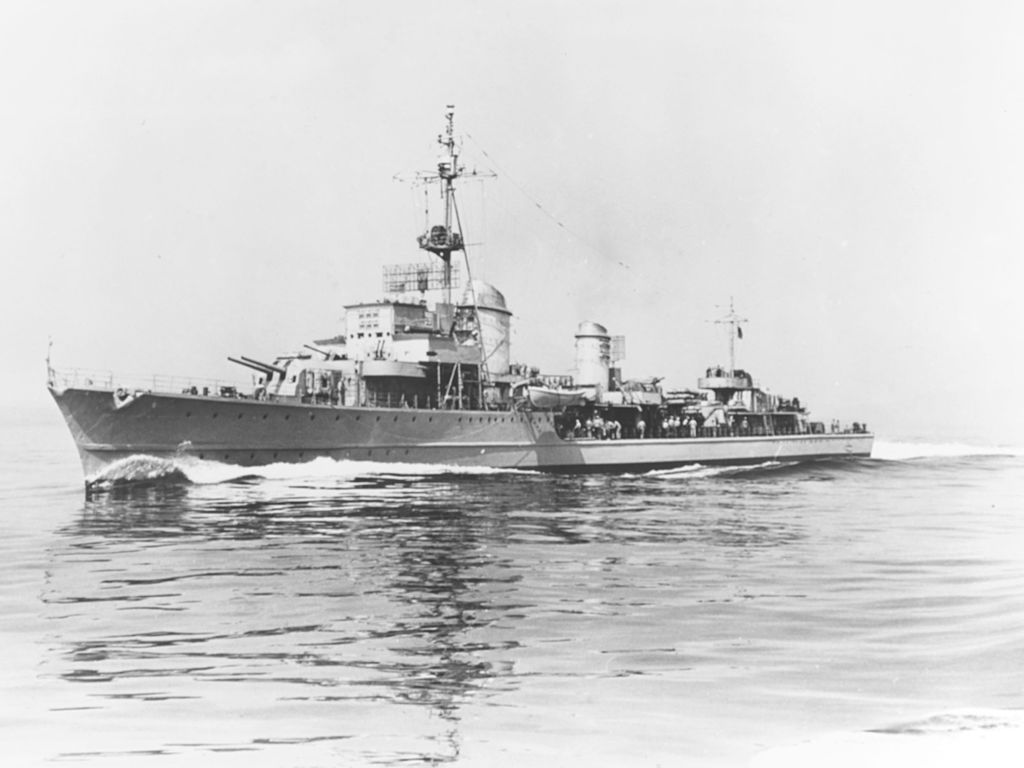
Two views of the Z39, a Mob type, sailing to the US after attribution by the allied commission. Most CC photos of the class are from her either underway or in the US.
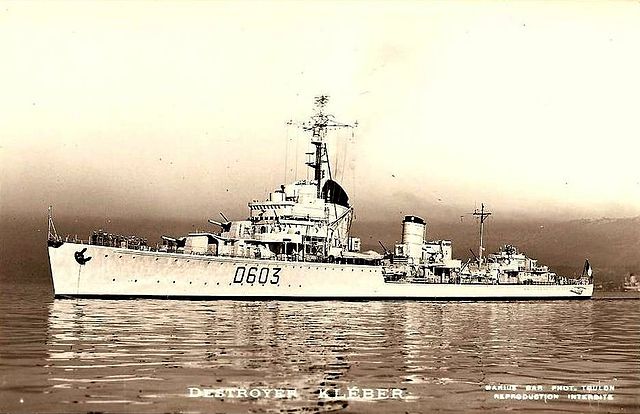
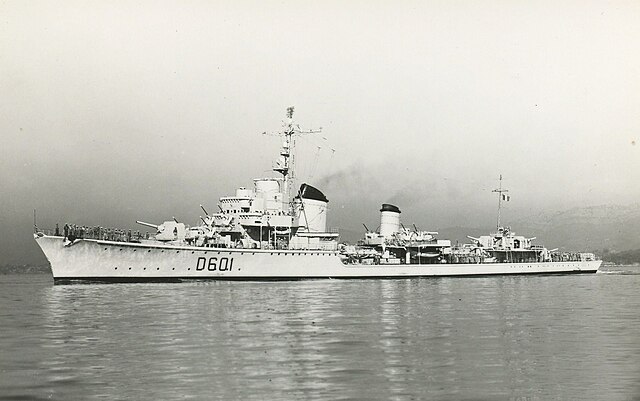
Kléber and Marceau, two of the four destroyers of the class obtained by France as war reparation, forming the bulk of escort forces postwar until modernization and service until around 1956.
Operational Service of the Type 1934A destroyers
 Z23
Z23
No cc photo
Z23 was laid down on 15 November 1938 at Deschimag of Bremen, launched on 14 December 1939 and completed on 15 September 1940. After working up she escorted vessels from Baltic to southern Norway in March to June 1941, such as KMS Bismarck Admiral Hipper, or Admiral Scheer. On 12–13 June she also escorted Lützow to the Atlantic until attacked by Bristol Beaufort aircraft off the Norwegian coast on 13 June, forcing her back after torpedo damage. Z23 was transferred to Brest on 16 June with Z24 to escort back Scharnhorst through the Bay of Biscay on 20–24 July and the merchant raider Orion on 21–28 August until ordered back to Norway on 23 October, Tromsø. She ended at the 8. Zerstörerflottile under Kapitän zur See Hans Erdmenger.
On 17 December, Z23, Z24, Z25, and Z27 made a raid in the Barents Sea and the the Kola Peninsula in search of allied ships and Z25’s radar spotted two merchants at 37.5 kilometers (23.3 mi) in heavy fog. These turned out to be the minesweepers Hazard and Speedy trying to catch up with Convoy QP 6. Accurate gunfire was near impossible and they escaped after four hits on Speedy. On 13 January 1942, Z25, Z23 and Z24 laid a minefield in the western channel of the White Sea. On the 20th, Z23 rammed Z24 in heavy fog, sending her for long repairs.
She escorted the minelayer KMS Ulm to Narvik to take part in Operation Zarin off the island of Novaya Zemlya (24-28 September) covered by KMS with Admiral Hipper and with sisters Z28, Z29, and Z30. On 23–24 October she escorted Tirpitz and Admiral Scheer from Bogen Bay to Trondheim and then Nürnberg to Altafjord but developed engine problems, missing Operation Regenbogen.
On 5 March 1943, the 8. Zerstörerflottile (Z23, Z24, Z32, Z37) was sent to the French Atlantic coast in Operation Karin via the channel, dodging fire from the British coastal artillery and motor torpedo boats. Z37 ran aground at Le Havre however. They covered the Italian blockade runner Himalaya to the Far East on 28 March and on the 30th the blockade runner Pietro Orseolo through the Bay of Biscay, torpedoed by an American submarine and finished off by Bristol Beaufighter and Beaufort. The German destroyers shot down five of these. Himalaya sortied again on 9 April, until spotted by a Short Sunderland and the flotilla was attacked by Vickers Wellington bombers and Handley Page Hampden used as torpedo bombers. They short down five but Z23 had a near miss, 5 dead and 31 wounded. Next they escorted U-Boats, and on 24–26 December, Z23 escorted the 6,951 GRT blockade runner MV Osorno. In heavy seas she lost four men overboard while back to Bordeaux.
She was to meet the arriving the 2,729 GRT refrigerated cargo ship MV Alsterufer with the 8. Flotille plus the six torpedo boats of the 4. Torpedobootflotille from 27 December. Thanks to “Ultra”, the allies planned their attack and positioned cruisers and aircraft in Operation Stonewall. A Consolidated B-24 Liberator heavy bomber sank Alsterufer later.
The German were unaware of this and arrive to the RDV point, spotted by another Liberator on the 28th. Soon the cruisers Glasgow and Enterprise sailed out in interception at full speed, in poor weather. By then, the whole German foltillas were turning back.
HMS Glasgow was the first to open fire at Z23 and Z27 at 13:46 from 19,600 meters (21,400 yd) by radar, then HMS Enterprise. Z23 fired six torpedoes down to 17,000 meters (19,000 yd) and missed and soon all destroyers fired back. On paper, they had about as much 6-in guns as their opponents. At 14:18 Erdmenger ordered to split forces. Z23 and Z27 took three torpedo boats and reversed course to the north. Z23 fired another torpedo and missed but they were the ones chased off. Z27 was hit in her forward boiler room, lost speed and fell behind. Glasgow and Enterprise concentrated on the torpedo boats at 14:39, sinking two. Z23 tried to assist Z27 but disengages as Enterprise appeared and she tried to flee with T22. She reached Saint-Jean-de-Luz, SW France close to Spain.
On 30 January 1944, Z23 was in exercises in the south of the Bay of Biscay with Z32 and Z37 when colliding with the latter, and the impact detonated a torpedo warhead. She lost her turbines and a fire started amidships. Z23 towed her to Bordeaux but there she was declated a total loss. Her escort of uboats through the bay was interrupteds by a refit at Pallice where she was attacked by 14 Avro Lancaster on 12 August. One of these bombs entered her forward boiler room and detonated under her bottom, plus there was a nasty near-miss. She flooded and listed to port, pumps connected to shore power being knocked out. She was later declared a total constructive loss, decommissioned on 20 August, stripped. She was refloated by the French Navy in 1945, towed the ship to Cherbourg and used as spares for the French ex-German prize DDs. She was scrapped from 7 October 1951.
 Z24
Z24
No photo
Z24 was ordered from AG Weser or Deschimag on 23 April 1938, laid down at yard number W958 on 2 January 1939, launched on 7 March 1940, commissioned on 23 October. Like her sister Z23 she started escorting ships between the Baltic and Norway in March 1941 and by June she escorted Lützow. She was transferred to Brest and escorted Scharnhorst on 20–24 July the the raider KMS Orion until back to Norway, Tromsø, entering the 8. Zerstörerflottile. She tok part in the Barents Sea sortied on 16 December 1941, Kola Peninsula and brief fight against HMS Hazard and Speedy. On 13 January 1942 she laid the White Sea minefield but was rammed in heavy fog by Z23 on 20 January and had long repairs at Wesermünde until March 1942.
Next she escorted Admiral Hipper to Norway on 18 March. She sailed out to Varangerfjord for the mission against Convoy PQ 13, rescuing 61 survivors of the sunken freighter SS Empire Ranger and sank the straggling 4,687 GRT freighter SS Bateau, rescued 7 survivors. They were spotted by radar by the cruiser HMS Trinidad and destroyer HMS Fury at 08:49 on the 29th. Both sides duelled at point-blank range, 3,200 yards (2,900 m) in a snowstorm. Trinidad engaged and badly damaged Z26, then Z25 whereas the latter fired a combined 19 torpedoes which all missed biut force Trinidad to turn away, taking two 15 cm gun hits. Z26 was separated from her sisters and later caught back by Trinidad and Fury until Trinidad was crippled by one of her own torpedoes.
HMS Eclipse went on in pursuit as Fury assisted Trinidad. cruiser. Z26 lost power at 10:20 and when Eclipse was about to torpedo her, she was surprised by Z24 and Z25 emerging from the snowstorm, hitting her twice until blinded by a squall at 10:35. They took 88 survivors from Z26 which was scuttled.
Next they met Z7 Hermann Schoemann to escort Zerstörergruppe Arkti (Alfred Schulze-Hinrichs) in search of Convoys PQ 14 and QP 10 on 11 April 1942.
On 30 April, U-456 torpedoed Edinburgh, escorting Convoy QP 11. The destroyers were sent to finish her off. But they also encojntered the convoy and attacked in limited visibility over four hours, but kept at bay each time by British destroyers. Flotilla Kaptain Schulze-Hinrichs seeing their supply ran dry decided to break off the attack and search for Edinburgh, finding and sinking instead the 2,847 GRT freighter SS Tsiolkovsky and the destroyer Amazon, with gunfire. Edinburgh wmeanwhile was escorted by two destroyers and four British minesweepers plus a Russian tugboat, steaming under her own power at 3 knots on 2 May when spotted by the Germans. Z7 Hermann Schoemann was the first to engage the minesweeper HMS Harrier at 06:27. Edinburgh tried to speed up to 8 knots but circled. Z7 managed to arrive at 21 knots on her flankl launched torpedoes at 2,800 meters (3,100 yd), and fled under smoke but was hit and bled speed. Z25 engaged HMS Forester and disabled her two guns and power but she was saved by Foresight passed in front, hit four times, having a single gun operable. The cruiser received a torpedo, had her engines down and started to list to port. Z24 and Z25 rescued the crew of Z7 under fire and laid a smoke screen. Z7 was scuttled and they came back to Norway. Z24 was unscathed, Z25 was hit once.
Z24 took part in the early phase of Operation Rösselsprung against PQ 17 in July. They did not ezcorted Lützow and Admiral Scheer, the other pincer, but Admiral Hipper and Tirpitz. Lützow and three destroyers of Tirpitz’s escort however ran aground and the operation was cacelled, but she escorted one of the damaged destroyers to Kiel before being refitted herself at Wesermünde until January 1943.
On 5 March 1943, the 8. Zerstörerflottile was sent to the French Atlantic coast in Operation Karin, starying escorting various ships and later U-Boats in the contested Bay of Biscaye. She escorted Italian blockade runner Himalaya on 28 March, and the Pietro Orseolo later, then Himalaya on 9 April. On 14 June Z24 and Z32 resccued survivors from U-564 on U-185. On 24–26 December she escorted the 6,951 GRT blockade runner MV Osorno and the 2,729 GRT refrigerated MV Alsterufer on 27 December. The was a clash on 28 December (see above) leaving Z27, T25 and T27 sunk.
Z24 was refitted at La Pallice from 14 January 1944 until early May after after D-Day on 6 June Kapitan zur See Theodor von Bechtolsheim ordered Z24, Z32, ZH1, T24, to sail for Brest and started night missions against the invasion fleet. They were attacked underway by Beaufighters. Z32 was damaged by rockets but shot down one. From Brest, Z24 and Z32 had AA augmentations and on 8/9 June they sortied for Cherbourg, until intercepted by eight Allied destroyers (10th Destroyer Flotilla) in what became the Battle of Ushant. The Germans were spotted first by radar, and fired at first. Each German DD launched four-torpedos but missed. Return fire was very effective and Z24 was badly damaged as she fired her first salvo at very close close. Even their 40 mm (1.6 in) and 37 mm guns barked on both sides. Z24 was hit by five 4.7 in (120 mm) shells but fled under smoke. She lost the 15 cm loading room for the turret, her forward superstructure was ruined, 13 men killed, the radio room as well, the forward engine room, aft funnel flakvierling, with a huge fire. Two Canadian destroyers pursued Z24 and T24 until they reached the safety of a minefield and Brest later. Z24 was under repair at Bordeaux from 13 July to 5 August 1944 but on the 14th, she was attacked by Allied fighter-bombers off Royan, struck by five 5-in rockets and ninety 20 mm shells which sent her back to Bordeaux where she was attacked by Beaufighters off Le Verdon-sur-Mer on 24 August. She managed to reach the quay the next day but capsized and sank, her crew integrated in Festung Gironde until May 1945.
 Z25
Z25
Z25 was ordered at Deschimag on 23 April 1938 laid down at yard W959 on 15 February 1939, launched on 16 March 1940, commissioned on 30 November and completed working up on 26 June 1941. While heading for Norway she ran aground off Haugesund and was sent back to Bremen for repairs. She was assigned to the Baltic Fleet to escort Tirpitz to the Sea of Åland on 23–29 September to prevent the Soviet Baltic Fleet to breakout from the Gulf of Finland. Z25 soon joined Z23 and Z27 to Tromsø on 6 December with the 8. Zerstörerflottile. In Kirkenes she replaced Z26 as flagship, Kapitän zur See Hans Erdmenger, commander. She led Z23, Z24 and Z27 on 16 December 1941 to the Kola Peninsula. Her radar spotted two ships at 37.5 kilometers (23.3 mi), which were Hazard and Speedy (they escaped). Not only all three destroyers spent a large part of their main shells, but Z25 and Z27 fired 11 torpedoes for nothing. On 13 January 1942 they laid a minefield in the White Sea.
On the 29th they met Z7 Hermann Schoemann at Vlissingen and then headed for Brest (7 February) for the Channel Dash on 11 February. Later they escorted Prinz Eugen and Admiral Scheer to Trondheim. On 6 March they escorted Tirpitz against Convoy QP 8 and PQ 12 (Operation Sportpalast). Admiral Otto Ciliax orfered the destroyers to search independently for Allied ship. They spotted and sank the 2,815 GRT SS Ijora, but were ordered the destroyers back to Trondheim as they lacked fuel.
On 28 March, Z26, Z24 and Z25 allied out of Varangerfjord against PQ 13. Then they met HMS Trinidad on the 29th and a battle commenced. Z26 was badly damaged bu she hit Trinidad twice. Z26 was accidentally became separated from her sisters and was caught by HMS Eclipse and crippled at 10:20 but saved at the lat moment by Z24 and Z25. They took from her 88 survivors.
Later joined by Z7 they joined Zerstörergruppe Arktis under Kpt. Alfred Schulze-Hinrichs against PQ 14 and QP 10 on 11 April. On 30 April they were sent to look for the torpedoed HMS Edi,brugh. Itw as already covered above. Long story short, for four hours they exhanged fire with escorting British destroyers and later claimed SS Tsiolkovsky, HMS Amazon and were orfdered back to search for Edinburgh on 2 May. Z25 initially engaged HMS Forester and hit her three times at 06:50 and then Foresight when she passed in front of her. Z24 and Z25 rescued the crew of Z7 and fodled back to port. Z25 had been hit in the radio roo (4 KiA, 7 wounded). She took part in Operation Zauberflote with Z5 Paul Jacobi and two torpedo boats, escorting back for repairs the damaged Prinz Eugen from Trondheim to Kiel on 16–18 May. Next she had a main overhaul until November.
On 11 November she escorted Nürnberg from Swinemünde to Trondheim. In February 1943 she was to be deployed to France, but kept in repairs due to engine problems on 5 March. She was back to Norway in April 22, kept inactive due to the same and repairs in Germany by August. She hit a mine in sea trials and was sent back for more repairs. Later she was assigned to the 6. Zerstörerflotille, sent in the Gulf of Finland to support minelaying operations from Reval in Estonia, starting on 13 February 1944.
The flotilla escort convoys between Libau and Reval and laid a first minefield in Narva Bay on 12 March also shelling Soviet positions and more such missions in July. She was prepared for Operation Tanne West, the occupation of Åland for a possible Finnish surrender, escorting Lützow to Utö on 28 June, until canceled. On 30 July and 1 August she was in the Gulf of Riga to shell Soviet positions inland. On 5 August she escorted Prinz Eugen shelling Oesel in Estonia, and Latvia 19–20 August. Until 20 September they evacuated 23,172 people from Reval. On 21 August with Z28 she recued 370 from Baltischport to Libau. Se did the same in the Sea of Åland to Gotenhafen and on 10 October, carried 200 reinforcements to Memel, evacuated 200 female naval auxiliaries and when back, shelled targets near Memel.
On 4 November she was assigned to the reconstituted 8. Zerstörerflotille to support Lützow and Prinz Eugen shelling the Sworbe, Saaremaa, on 19-24 November. She had a refit in December and dealt with Soviet troops near Königsberg with Prinz Eugen on 29–30 January 1945 and 2–5 February. She escorted then refugee ships between Gotenhafen and Sassnitz and more soviet troops shellings. On 26 March with Z5 she escorted the ocean liner Potsdam, troopship SS Goya, target ship Canonier with 22,000 refugees to Copenhagen. She did the same from Hela into May. On the 5th, she escorted 45,000 refugees to Copenhagen and 20,000 more to Glücksburg on the 9th but was decommissioned on the 10th.
postwar Z25 wasn sent to Wilhelmshaven, overhauled and attributed to the Allies as war reparations. She was allotted to Great Britain by late 1945, sent to Rosyth on 6 January 1946. She was then allocated to France and sent to Cherbourg on 2 February. Recommissioned as Hoche, 1st Divisionof contre-torpilleurs she escorted the carrier Arromanches and in 1947, the battleship Richelieu. She was in reserve on 1 January 1949. and until 1953 was rebuilt into a escorteur rapide with new weapons and electronics, based in Toulon, decommissioned on 1 September 1956, sold 30 June 1961.
 Z26
Z26
no photo
Z26 was ordered from Deschimag on 23 April 1938, laid down at yard number W960 on 1 April 1939, launched on 2 April 1940, commissioned on 9 January 1941. She escorted Tirpitz to the Sea of Åland on 23–29 September 1941 and on 9 November with Z24 sailed for Tromsø. But her lubrication pump, starboard low-pressure turbine broke down and she lost rotor blades. She was fully repaired on 14 December and joined the 8. Zerstörerflottile at Kirkenes, loosing another lubrication pump. She was back in Germany on 5 January 1942 for a refit and escorted Admiral Hipper from Brunsbüttel to Trondheim on 18 March, then Admiral Scheer from Trondheim to Narvik.
On 28 March she became flagship, Kapitän zur See Gottfried Pönitz. They sallied out of Varangerfjord against PQ 13. same as above. Rescued 61 survivors from SS Empire Ranger, sank SS Bateau. She was part of the battle against HMS Trinidad and HMS Fury. Z26 was hit by Trinidad’s second salvo and she lost two 15 cm guns, her port turbine room while having a large fire. Partly saved by a volley of 19 torpedoes she hit Trindad twice with her remaining 15 cm guns, minor damage. Separated from her sisters she was caught back by Trinidad and fired upon at 09:17 from 2,900 yards (2,700 m). Wildly maneuvering she managed to land a few hit from her 37 main-guns but took a torpedo five minutes later, two other failing to leave their tubesn blocked by ice. The one launched in adition started to circle back around and struck Trinidad. HMS Fury took on the pursuit from there, but missed Z26, which wa slatter spotted in a snowstorm by Soviet Sokrushitel’nyy and Gremyashchiy. In the confision later Fury took Eclipse and fired two salvoes at her until recognizing her our and joined to assist Trinidad. Eclipse spotted Z26 by radar at 2 nautical miles (3.7 km; 2.3 mi) and opened fire when spotting her shape at 800 yards (730 m). Z26 launched a smoke screen, but took several hit. The sixth had her loosing all power at 10:20. She listed to port soon her stern was awash. The British destroyer closed in to fire her last torpedo when Z24 and Z25 approached and fired at her. Hit, she withdrawned and they took off 88 survivors. U-376 later picked up 8, but Z26 sank with 243 crewmen, most killed during the exchanges.
 Z27
Z27
piccc
Z27 was ordered from Deschimag) on 23 April 1938, laid down under yard number W961 on 27 December 1939, launched on 1 August 1940, commissioned on 26 February 1941. Under Korvettenkapitän Karl Smidt she escorted Tirpitz into the Sea of Åland (23–29 September), then was in Tromsø, 8. Zerstörerflottile. She sailed to the Barents Sea on 16 December, engaged Hazard and Speedy. She had engine problems and propeller shaft issues, refitted from 5 January 1942 and back in May taking part in Operation Rösselsprung until abandoned. Z27, Z30 Z4, Z16 laid a minefield off the Kanin Peninsula, White Sea claiming later the Soviet icebreaker Mikoyan. She escorted Admiral Hipper in interception to ships leaving Soviet ports in early November. Z27 was awared of a tanker signalled by the Arado 196 of Admiral Hipper on 7 November. She sank the submarine chaser BO-78 and eventually the 8,000 GRT Soviet oil tanker Donbass, rescuing survivors of both.
On 2 December she was refitted in Bremen and back in Norway for 15 June 1943. With Z30 she had minelaying missions off southern Norway in June. She took part in the raid on Spitsbergen in September, landing troops. On the 24th she escorted Lützow to Kiel and was sent to France on 31 October with ZH1 and damaged by splinter fire while off Le Verdon-sur-Mer, by British coastal artillery. 5 November saw them attacked by British motor torpedo boats off Cap d’Antifer. She became flagship KsZ Hans Erdmenger 8. Zerstörerflotille, escorting the 6,951 GRT blockade runner MV Osorno, 2,729 GRT refrigerated MV Alsterufer. On 27-28 December she was part of the battle of Biscaye when engaged by HMS Glasgow and Enterprise. Glasgow engaged Z27 and Z23 at 13:46 from 19,600 meters (21,400 yd), then Enterprise. Z23 fired six torpedoe and missed while all destroyers started firing back. At 14:28, Z27 fired four torpedoes and missed, while Erdmenger decided to split. Z27 fired remaining torpedoes, missed and as part of the northern group she was hit by HMS Enterprise in No. 2 boiler, loosing her starboard main steam line. The other boilers were also crippled by shrapnel and the next feed pumps failed, Glasgow spotted latter the drifting Z27, closed in point-blank and send her to the bottom by gunfire at 16:41. 93 were rescued by a German submarine and Spanish destroyers later, even the Irish merchantman, MV Kerlogue. 300 went down.
 Z28
Z28
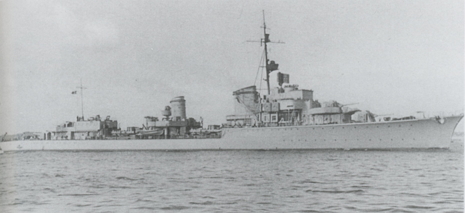
Z28 was ordered from Deschimag on 23 April 1938, laid down at yard number W962, 30 November 1939, launched on 20 August 1940, commissioned on 9 August 1941 under Korvettenkapitän Hans Erdmenger. Se trained and worked out until early 1942 from Aarhus, Denmark, patrolingd the Skagerrak and Kattegat. Next she was was transferred to Norway in April and escorted convoys. She escorted Scheer with Z30 and the oiler Dithmarschen to Narvik on 9 May. She took part in Operation Rösselsprung, later abandoned. Also to Operation Zarin, minelaying Novaya Zemlya on 24-28 September with Z23, Z29, and Z30. On 1 October she escorted Admiral Hipper to Bogen Bay and Tirpitz, Admiral Scheer to Trondheim. She was later refitted in Kiel.
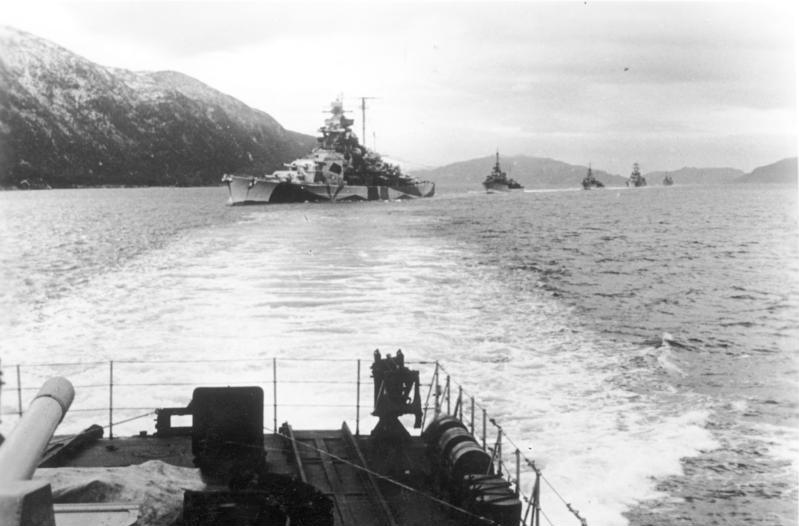
In early March 1943, she escorted Scharnhorst to Bogen Bay. Underway from Altafjord to Harstad with Z4 on 2 April she ran aground, ater repaired in Trondheimand under an air raid on 24 July. She was later at Deschimag for complete repairs. Bacll in Kristiansand she took on anti-contraband patrols from 7 January 1944 as part of the 6. Zerstörerflotille. On 12–13 February she laid a minefield in the Skagerrak. The 6th Flotilla was transferred to the Gulf of Finland for more minelaying operations, from Reval late February. Next she escorted convoys between Libau, Latvia, and Reval, laid a minefield in Narva Bay on 12 March and others until July. She took part in the cancelled Operation Tanne West.
On 30 July and 1 August Z28 she was operating in the Gulf of Riga, shelling Soviet positions and on 5 August, escorted Prinz Eugen attacking Oesel on 19–20 August. Z28 and Z36 escorted the troopship MV Monte Rosa from Baltischport to Gotenhafen on 16 September. On the 20th she escorted a convoy of 23,172 people from Reval and with Z25 on the 21st, carried 370 from Baltischport. On 22 August, she escorted more in the Sea of Åland to Gotenhafen and resumed shore bombardment missions on 10 October on Memel and the Sworbe peninsula, Saaremaa, but was attacked by Soviet aircraft (9 Ki, 20+ wounded) and was back in Swinemünde for repairs until 25 February 1945. She escorted the ocean liner Deutschland to Sassnitz and evacuated Germans from the Polish Corridor (Operation Hannibal) but o, 4 March she was sunk in port two days by RAF bombers, hit by two bombs amidships.
 Z29
Z29
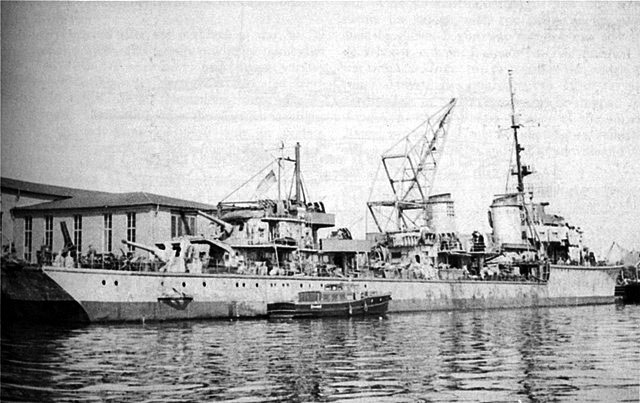
Z29 was ordered from Deschimag on 23 April 1938, laid down under yard number W963 on 21 March 1940, launched on 15 October, commissioned on 25 June 1941 under Korvettenkapitän Curt Rechel. She escorted Tirpitz from the Jade to Trondheim and back to Kiel 14-17 January 1942 and on the 27th sailed for Brest for its Channel Dash as flagship, under Führer der Zerstörer Erich Bey. Later the battleship Scharnhorst struck a mine in the Scheldt Estuary and Vizeadmiral Otto Ciliax ordered Z29 to take him aboard. While trying to board, she collided with her stern, damaging her forecastle but managed to take off the vice admiral and depart. She had a 15 cm shell exploding in one of the aft guns whih severed oil lines and she lost her port turbine. Ciliax was then transferred to Z7 and Z29 was sent for repairs at Wesermünde. She later escorted Tirpitz and reached Trondheim by October 1942.
She screened Lützow from 15 to 26 May to Bogen Bay, and laid a minefield in the Skagerrak. On 5–8 September with Z30 and Z4 she laid a minefield in the Kara Strait close to Novaya Zemlya and Vaygach Island. She took part in Operation Zarin off Novaya Zemlya with Admiral Hipper and on 23–24 October, escorted Tirpitz and Admiral Scheer to Trondheim. She went on to Copenhagen with Scheer, and back to the Altafjord with Nürnberg.
On 30 December, she took part in Operation Regenbogen on Convoy JW 51B. Vizeadmiral Oskar Kummetz splitted his forces and she Z29 was assined to the escort of Admiral Hipper with Z4 Richard Beitzen and Z16 Friedrich Eckoldt, north of the convoy. They separated from Admiral Hipper to search for the convo and found it on 31 December, spotted and attacked by HMS Obdurate and engaged from 8,000 meters (8,700 yd). But they were soon ordered to rejoin Hipper, sinking underway the minesweeper HMS Bramble. Hipper next engaged convoy escorts in poor visibility until caught by the British covering force (HMS Sheffield and Jamaica). Meanwhile the German destroyers were still far from Hipper. Z29 lost contact and the other two destroyers were taken by Hipper by Sheffield, and engaged at 4,000 meters (4,400 yd). Z16 was sank with all hands. Z29 later joined and escorted back home Köln and the damaged Admiral Hipper on 24 January 1943 to Kiel. She had only refit at Wesermünde.
She was back in Norway on the 22 July with Z33 and later Z31 as part of 4. Zerstörerflotille and took part in Operation Zitronella on Spitsbergen for landing troops and fire support ashore. Z29 was hit four times by coastal artillery (3 killed, 3 wounded). She later escorted Scharnhorst for Operation Ostfront on 25 December against JW 55B. She was detached to seach for targets independently and missed the Battle of North Cape.
Z29 had her boilers repaired in early 1944, stayed in Norway and on 17 July attacked by the RAF (Operation Mascot) with superficial damage. In October 1944 she escorted convoys during Operation Nordlicht, the evacuation of northern Norway. On 16 December with Z31 she laid a minefield off Honningsvaag. Next she sailed from Laafjord for Wesermünde for a last refit that (forward gun replaced by a twin-gun turret and AA) until May 1945, but as Germany surrendered she was decommissioned on the 7th. Allocated to the United Statesby late 1945 her poor state saw her declined and she was scuttled at the entrance to the Skagerrak on 10 June 1946 with many chemical munitions aboard.
 Z30
Z30
no pic
Z30 was ordered from Deschimag on 23 April 1938, laid down as yard number W964 on 14 January 1940, launched on 12 August, commissioned on 15 November 1941 and accidentally collided with the German submarine U-216 on 14 January 1942 dring trials. On 18 March she escorted Admiral Hipper from Brunsbüttel to Trondheim and Admiral Scheer from Trondheim to Narvik. She was mobilized for Operation Rösselsprung against PQ 17 in July 1942. On 5–8 September with Z29, Z4 she laid a minefield in the Kara Strait and was in Operation Zarin at Novaya Zemlya. On 13–15 October she laid a minefield off the Kanin Peninsula. She escorted Admiral Hipper in early November for an interception, co-claimed the Soviet oil tanker Donbass and BO-78.
On 30 December she escorted Lützow and Admiral Hipper for Operation Regenbogen on JW 51B under Vizeadmiral Oskar Kummetz, assigned to Lützow with Z6 Theodor Riedel and Z31, south group, but they failed to press home their attac and only damaged one merchantman. Z30 escorted back Köln and the damaged Admiral Hipper on 24 January 1943 to Kiel and was refitted.
Back to Norway she was in minelaying missions with Z27 and took part in Operation Zitronella on Spitsbergen, hit by coastal artillery but slightly damaged. She escorted also Scharnhorst for Operation Ostfront on 25 December against JW 55B and detached, and did not protected the battlecruiser in the Battle of North Cape. She was later based in southern Norway, escorting convoys and laying minefields with a refit at Swinemünde. 31 August saw her in the western Baltic and Skaggerak. She escorted a convoy on 20 October but struck a mine off Oslofjord. Her stern compartment was flooded and she lost her port turbine, starboard propeller shaft. She ws towed to Oslo for initial repairs, and was still there when Germany surrendered on 8 May 1945 so she was decommissioned on 14 May.
As war reparation she was turned over to the Royal Norwegian Navy, only for maintenance purposes from 15 July, later allotted to the British; towed to Rosyth on 6 February 1946 and only used for underwater explosions tests, to Loch Striven and tested between May and September 1948 with notably 500 kgs (1,100 lb) charges of torpex at various depths. She survived and was sold for scrap on 9 September in Dalmuir.
 Z31
Z31

Z31 as Marceau postwar.
Z31 was ordered 19 September 1939, built at AG Weser (Deschimag) in Bremen, laid down on 1 September 1940, launched on 15 May 1941, commissioned on 11 April 1942. She had a lengthy work up and was damaged in collision with a schooner on 6 November 1941, then transferred to operations in Norwegian waters only by December 1942. On the 30th she left Altafjord with Admiral Hipper and Lützow as well as her near-sisters Friedrich Eckoldt, Richard Beitzen and Theodor Riedel, Z29 and Z30 for Operation Regenbogen on convoy JW 51B. After the split none of the destroyers could approach the 15 merchant ships in the convoy, repelled time and again by destroyers, some being the old A/B class were just saw.
On 5–6 February 1943 she escorted the minelayer Brummer off Kildin Island. On 10–11 she escorted Lützow from Kaafjord to Narvik. On 6 September 1943, she escorted Tirpitz and Scharnhorst for Operation Zitronella to Spitzbergen. Z31 was hit eight times by coastal artillery off Barentsburg, 8 September, 1 killed, 1 wounded but moderate damage. In November, she was sent to southern Norway for patrols and laying defensive minefields in the Skagerrak, 4–7 December.
After a refit at Wesermünde until August 1944, she was sent back to Norway, damaged by carrier-borne fighters as the raid on Tirpitz in the Altafjord proceeded on 29 August. In October 1944, she took part in the evacuation of the 20th Mountain Army from northern Finland and Norway after the Soviet Petsamo–Kirkenes Offensive. She also took part in minelaying operations off Honningsvåg with Z29, 16 December and Z33, 27 December as well as off Hammerfest with Z33, 3 January 1945.
On 25 January 1945, with the 4th Destroyer Flotilla (Z31, Z34, Z38) she left Tromsø for the Baltic and on the 28th they were caught underway by British cruisers Mauritius and Diadem in the Sognefjorden (north of Bergen). Z31 received 7 hits: Forward turret wrecked, 55 men killed, 24 wounded. She reached Bergen for temporary repairs, then moved to Horten and Oslo and eventually arrived in the Baltic.
On 22 March 1945 she teamed with Z31, Z34 and Lützow to shell advancing Soviet troops near Gotenhafen. The next day she towed the hulk of Gneisenau to the entrance of Gotenhafen, sunk later as blockship, 27 March. The same day she had 15 cm shell accidentally exploding in a gun, killing 4, wounding 18. She went on iwith the evacuation of German troops and civilians from Gotenhafen until damaged by Soviet bombers, withdrawing westwards with Prinz Eugen and Lützow, 8 April. Docked at Swinemünde for repairs she was damaged by another Soviet air attack on passage to Kiel on the 27th but arrived at Brunsbüttel on 30 April, with no repairs made until 8 May.
Postwar she was transferred as was reparation to Britain, which ceded it to France. Z31 had a new career as Marceau until 1953 (see French cold war section for more). She was modernized and served in the Mediterranean from Toulon. She was sold for BU in 1958.
 Z32
Z32
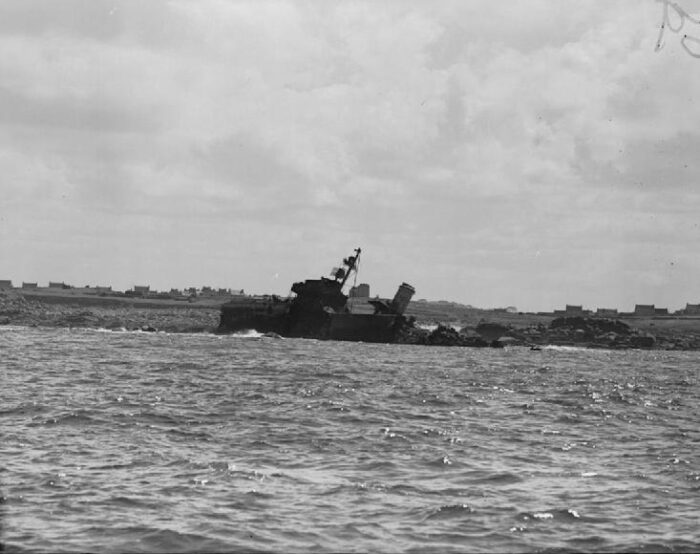
Z32 wrecked at Ile de Batz, Britanny
Ordered 19 September 1939, Z32 was built at AG Weser (Deschimag), laid down on 1 November 1940, launched on 15 August 1941 and completed on 15 September 1942. She joined the 8th Destroyer Flotilla and was transferred via the Channel to the French Atlantic coast in Operation Karin 5–8 March 1943, being fire at by Dover batteries. She arrived in Bordeaux on 8 March. On the 28th she was in distant escort for the Italian blockade runner Himalaya (9 TBs in close escort) but force back after British air reconnaissance. On 30 March, Z32, Z23, Z24, Z37 sailed to meet and escort back the blockade runner Pietro Orseolo. They fended off British air attacks but Pietro Orseolo was damaged by a torpedo from the sub USS Shad, still made it in the Gironde estuary on 2 April. On the 9th April escorted Himalaya again, repelled by British air attacks. She also escorted sorties of U-boats.
On 24 December her 8th Destroyer Flotilla (six destroyers) and 4th Torpedo Boat Flotilla (six) sortied to meet the blockade runner Osorno on 25 December. They fended off air attacks and managed to reach port although she had to be beached to save her cargo. On 26 December same for Alsterufer, but she had been already sunk on the 27th by a B-24 Liberator. On 28 December HMS Glasgow and Enterprise on patrol in the Bay of Biscay encountered both flotillas in what became the Battle of the Bay of Biscay. The German tried a pincer, prevented by the heavy seas. Z27, T25 and T27 were sunk. Z33 fired six torpedoes but missed. The others could not erven close.
On 30 January 1944, Z32 was in exercises with Z23 and Z37, south of the Bay of Biscay when colliding with Z37. Z37’s torpedoes exploded. Z32 remained in repairs until 2 May whereas Z37 was disarmed. Z32 was damaged on 5 May after running aground.
On 6 June 1944, the 8th Destroyer Flotilla (Z32, Z24, ZH1, T24) was sent to Brest against the invasion fleet. They were attacked by the RAF all along. Z32 was damaged by rockets and on 8-9 June, they tried to reach Cherbourg, until intercepted by eight Allied destroyers in what became the Battle of Ushant. ZH1 was sunk by HMS Ashanti, Z32 mauled by HMCS Haida and Huron (Tribal class). It was like the prefect match, but at 1 vs 2, she awas gradually baly damaged and started flooding, until running aground, wrecked on the Île de Batz where she remained until the end of the war, scrapped postwar.
 Z33
Z33
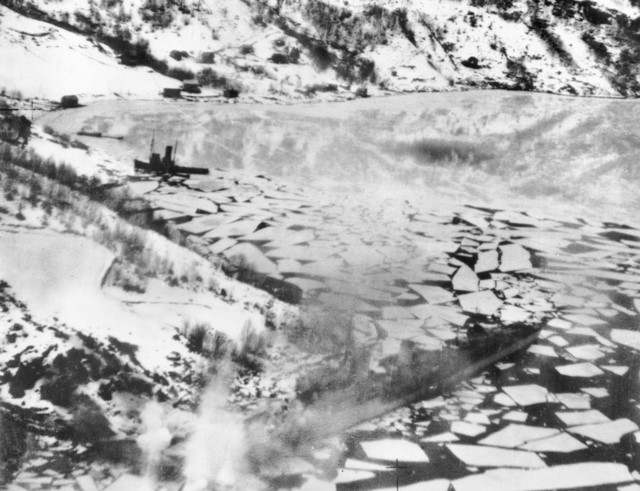
Z33 under air attack in the Forde Fjord, 9 Feb. 1945
Z33 was Ordered 19 September 1939 at AG Weser (Deschimag), Bremen, laid down on 22 December 1940, launched on 15 September 1941 and commissioned on 6 February 1943. Z33 was ordered from Seebeckwerft as a Type 1938B on 28 June 1939, until cancelled by September 1939, and re-ordered from AG Weser in Deschimag as a Type 1936A (Mob) on 19 September 1939. Construction was slowed by shortages of all sorts and her career was short.
She was sent to Norway on 22 July and took part in Operation Zitronella on Spitsbergen, hit by 33 shells from the coastal artillery (3 killed, 25 waounded). She escorted Scharnhorst during Operation Ostfront on 25 December to intercept JW 55B but was detached and missed the Battle of North Cape. On 17 July 1944 Z33 was strafed by RAF Corsair Mark I in Operation Mascot (Tirpitz raid), light damage. In October she took part in Operation Nordlicht, evacuation of northern Norway. On 27 December she laid a minefield off Honningsvaag with Z31 and Hammerfest, 3 January 1945.
Se sailed for home on 5 February, but ran aground in Brufjord, lost her port shaft and propeller and knocking out both turbines, with flooding. Under tow to Trondheim she was attacked by Bristol Beaufighter two days later while anchored in Førde Fjord due to poor weather. The attack cost her dearly due to rockets, although her and her escort managed to shot down seven Beaufighters, the “Black Friday” airstrike. After repairs were completed she sailed for Swinemünde on 26 March, arrived on 2 April. Shortage of fuel left hger stranded, her AA removed, until she departed on 27 April to be decommissioned at Cuxhaven. Postwar, she was overhauled just to keep her seaworthy and the Allies decided to allot her to the Soviet Union by late 1945, sailing on 2 January 1946 to Liepāja, Latvia and renamed Provornyy, Baltic Fleet. TS 30 November 1954, accommodation ship on 22 April 1955. Badly damaged by a fire and sank, refloated two years later, BU.
 Z34
Z34
Z34 like her ister Z33 was initially planned as a 1936B class ship, under reordered as a 1936A mob. She was laid down at AG Weser on 15 January 1941, launched on 5 May 1942 and completed on 5 June 1943 after all sorts of shortages and in low priority. She was working up while proceeding to on 1 November. She escorted Scharnhorst in Operation Ostfront on 25 December, but detached and missing the Battle of North Cape. She operated in the Arctic throughout 1944 adnd defended by AA the battleship Tirpitz, being damaged in the air raid of 17 July and 29 August. Her crew managed to save the oil tanker SS C. A. Larsen also. In October she took part in Operation Nordlicht. On 1 December, she towed a damaged troopship into Hammerfest and had a refit at Tromsø where from the 11th. On 22 January 1945 with Z31 and Z38 she laid minefields in Magerøya, Laafjord, and Brei Sounds.
On the 25th she left Tromsø for the Baltic until intercepted on the 28th by a RN squadron (Diadem, Mauritius) off the Sognefjord. Z34 tried torpedo attacks to cover the badly damaged Z31 withdrawal, under smoke and in the heavy weather, tall waves, they managed to outpace the cruisers and entered the Aspofjord, protected by German coastal artillery. Z34 ferried 200 artillerymen from Kiel to Gotenhafen on 3 February and later escorted Admiral Scheer in a shalling mission off Frauenburg for the 4th Army. Z34 evacuated refugees from Kolberg with Scheer, Lützow, and Prinz Eugen and shelled Dievenov and Tolkemit. She was credited twelve tanks and four anti-tank guns. She was under air attack on 29 March. On the 31th she was the first German destoryer using rockets to engage Soviet bombers. In April, she escorted the liners Deutschland and Pretoria with 17,000 refugees to Copenhagen. After a brief refit she shelled Soviet positions near Grossendorf (10th). She duelled with Soviet coastal artillery at Oxhöft, when one of her shells prematurely detonated in the barrel. It was replaced by one from Z33. While underway from Hela she was attacked by two Soviet motor torpedo boats on the night of 15/16 April, evaded one torpedo, but was hit by the other. This flooded her aft turbine room and she lost all power, listing to port. She was attacked by Soviet aircraft when one of her anti-aircraft rocket detonated on deck, killing 8, wounding 14. She was towed into Swinemünde by T36 and M204 for emergency repairs, her AA buffed with weapons from the wreck of Lützow. On 4 May she was in Copenhagen with refugees, decommissioned at Kiel on the 10th.
She was allocated to the US in late 1945. Due to her poor state she was scuttled in the Skaggerak on 26 March 1946.
 Z37
Z37
Z37 was ordered from Oderwerke Stettin as a Type 1938B on 26 June 1939, but after cancellation at G627 Germaniawerft as a Type 1936A (Mob) on 19 September 1939, laid down on 2 January 1940, launched on 24 February 1941, commissioned on 16 July 1942. She was not operational before 23 January 1943, escorting Scharnhorst and Prinz Eugen to Norway, albeit the operation was cancelled. On 5 March 1943, she entered the 8th Destroyer Flotilla (Z23, Z24, Z32, Z37) transferred via the Channel to Bordeaux in Operation Karin. Z37 ran aground at Le Havre underway on 6 March, starboard propeller damaged, under repair until 18 March
Ten days later she escort the blockade runner Himalaya. On 30 March, Z37 she escorted the blockade runner Pietro Orseolo. On 9 April, Z37 same for Himalaya, but foiled by British air attacks.
On 24 December 1943, both the 8th DesFlot and 4th TBFlot saled to met the blockade runner Osorno, repelling heavy air attacks. On 26 December her unit was sent to meet Alsterufer, sunk earlier but while underway they met HMS Glasgow and Enterprise in the Bay of Biscay. Z37 fired six torpedoes against the cruisers but missed.
On 30 January 1944, Z37 was in exercises in the south of the Bay of Biscay with Z23 and Z32 when she collided with Z32 and one of her torpedoes exploded. The fire set off some of her AA ammunition and she started to flood, towed back to Bordeaux, where she was examined, and declared a total constructive loss. Her guns were removed, her crew sent as ground troops. She was decommissioned on 24 August, scuttled, wreck was broken up later in 1949.
 Z38
Z38
Z38 was ordered on 19 September 1939, laid down by Germaniawerft in Yard G628 (Kiel) on 15 Aprilin 1940, launched on 5 August 1941, commissioned on 20 March 1943 and assigned to the 4th Destroyer Flotilla. By August 1943 she was a practice torpedo retrieval boat for KMS Nürnberg and Emden. On 24 September she sailed to Trelleborg, escorting Lützow in Operation Hermelin with Z5, Z14, Z15 and Z27. On 22 October she sailed to Kaafjord. On 25 December under Rear Admiral Erich Bey she escorted Scharnhorst alongside Z29, Z30, Z33, Z34 to intercept Convoy JW 55A and the next day, ey formed a patrol line using his destroyers. Just after they were ordered back to base, Scharnhorst was caught in the Battle of North Cape.
On 30-31 May 1944 she was in a patrol line between Bear Island and the North Cape. On 30 June-1 July she sortied to Bear Island. On 31 July she escorted Tirpitz into the Arctic Ocean from Altafjord in exercises. On 21-31 October she covered the evacuation of the Mountain Corps Norway unit. 6-17 November saw her covering the retreat from Tanafjord.
On 22 January 1945 with Z31, Z34 she laid mines in Magerøya, Laafjord, and Brei Sounds. On 25 January she sailed with the same to the Baltic. On 28 January while off the Sognefjord she met Diadem, and Mauritius. In the battle, one of her funnels caught fire and she lost boiler tubes, breaking off from the battle, managing to reach Kiel with Z34.
16-20 February 1945 saw her escorting the liner SS Hamburg to Sassnitz. On 22 February she escorted Deutschland to Sassnitz. On 18-19 she escorted Admiral Scheer, Z43, T28 and T35 to shell the Soviet 39th Army positions off Peyse, Gross-Heydekrug, Samland and also on 23 February. However Z38 and T8 became icebound, freed by tugs. 4-6 March saw Z38 shelling the Soviet avance near Wollin, and took refugees from Pillau to Gotenhafen. On 7 March with Z35 and T28 she escorted the steamship Pretoria to Copenhagen. On 13 March she shelled Großendorf. The remainder of the month saw her under control of the Wehrmacht and on 4 April her upper deck was damaged in an air raid. On 5 April she took part in the battle off Oxhöfter Kämpe. On 9 April she escorted Lützow and Prinz Eugen to Swinemünde. From 28 April to 4 May she defended Dievenow channel, Oder.
On 3 May with Z39 she escorted the pre-dreadnought TS Schlesien after she hit a mine near Greifswalder Oie to Swinemünde. On 4 May she carried refugees from Swinemünde to Copenhagen and the crew of the training ship Hektor, badly damaged in an air raid. On 7 May she sailed to Swinemünde to pick up more refugees to Copenhagen. On 8 May she left Hela to Glücksburg with 20,000 soldiers and civilians, and arrivedf the following day, learning of the capitulation. She ended in Kiel, deliverying her Diary to the Flensburg Förde commander, already decommissioned. She later sailed with mixed German-British crew to Wilhelmshaven and on 6 July for Portsmouth, becoming a trial vessel with her German crew remaining until 22 September 1946.
As HMS Nonsuch, she was used for testing as R40, and D107 in the Firth of Clyde. She was later laid up in the Portchester creek. In October she had extensive machinery trials, and became an air target ship in Rosyth. In January 1947 she was to relieve HMS Fernie as air target ship but by September 1948, paid off, reserve, done by mid-October. Her auxiliary machinery was exhibited to British shipbuilders and equipment remoged so by March 1949 she ended as a target trials, disarmed, towed to Loch Striven. In October 1949 a 500 Kg (1,100 lb) charge was detonated close to her hull. The water plums was described 250 feet (76 m) high, breaking her keel, flooded her machinery gradually, but she beached for inspection and sent to the shipbreakers on 8 November 1949 with the scrapping commencing in place from August 1950.
 Z39
Z39

Z39 was the most photographed of her class, courtesy of the USN.
Z39 was ordered on 26 June 1939, laid down by Germaniawerft (Yard G629, Kiel) on 15 August 1940, launched on 2 December 1941, commissioned on 21 August 1943, among the very last surface ships of the 3rd Reich. She was only “operational” from 7 January 1944. She was modified under Project Barbara, with three pairs of 3.7 cm (1.5 in) FLAK, one forward of her bridge, one abreast her aft funnel, one breast forward of her funnel with two single 3.7 cm (1.5 in) on her after funnel platform and two more twin 2 cm guns added to her bridge wings plus a Flakvirling (quad) 2 cm and two single 2 cm guns on her aft extended deckhouse. She started minelaying operations in the Skagerrak and Kattegat until March 1944, then sent to Reval off the Gulf of Finland, joining the 6th Destroyer Flotilla with Z25, Z28, and Z35.
12-13 February saw her laying the “Dorothea A” barrage. On 10 March, same, and on 11-12 March, she shelled Soviet forces at Narva-Jõesuu. 13 March to 22 April saw six minelaying operations, notably the “Seeigel 6b” mine barrage (Suur Tytärsaari) and “Seeigel 3b” (Vigrund Island, Narva Bay) under smokescreen due to coastal artillery. Until 24 April this was “Seeigel 7b/3” in Narva Bay and “Seeigel 8b” southwest of Suur Tyärsaari, 2,831 mines total.
On 23 June she was damaged by Soviet bombers at Paldiski, repaired in Libau from 29 June, the Kiel from 24 July, damaged after an RAF air raid, and back to Swinemünde with parts from the cannibalised from Z44 and Z45. She was damaged in the air raid on 29 July at Bremen, sunk with her superstructure remaining above water, repaired until 28 February 1945, sent to Sassnitz. Shortages of oil had her stuck there on 25 March and in Swinemünde, retuning in action from 1 April 1945 and until the 7th she escorted transports of Task Force Thiele in the Bay of Danzig. 8-9 April saw her providing gunfire support and on 10 April with T33 she escorted the damaged Z43 to Warnemünde and Swinemünde.
She was called by Army Group North along the Baltic Sea coast for escort and bombardment missions, resupplying and supporting garrisons and then evacuating hundreds of thousands of civilians and soldiers. On 15 April she escorted Matthias Stinnes, Eberhart Essberger, Pretoria and Askari to Copenhagen and on 2 May, shelled Soviet Army in the Oder estuary. On 3 May she moved with Schlesien to protect the bridge across the Peene river, Wolgast but the latter hit a mine near Greifswalder Oie so she towed her to Swinemünde to be grounded so that her guns could fire and defend the city. Z39 and three other destroyers and other ships sailed for Copenhagen with 35,000 wounded soldiers and refugees on board. After Germany surrendered on 8 May, evacuations were on, she was part in another 20,000 soldiers and civilians evacuation from Hela to Glücksburg until 9 May. She was decommissioned at Kiel on 10 May and sent to Wilhelmshaven with a German-British crew, then to Plymouth on 6 July 1945. The US claimed her as prize ship on 12 July so she left on 30 July for Boston on 7 August. On 14 September after extensive trials she was recommissioned as DD-939 (no name). She was used for extensive testings, notably her propulsion. By November she was retransferred to the French Navy, sent in Casablanca in January 1948, then Toulon, redesignated Q-128, and cannibalized for her parts to replair Kléber (ex-Z6), Hoche (ex-Z25), Marceau (ex-Z31). She remained as a pontoon for minesweepers near Brest until BU in 1964.
Read More
Books
Gröner, Erich (1990). German Warships 1815–1945. Vol. 1: Major Surface Warships. Annapolis, Maryland: Naval Institute Press.
Hervieux, Pierre (1980). “German Destroyer Minelaying Operations Off the English Coast (1940–1941)”. In Roberts, John (ed.). Warship. Vol. IV. Conway Maritime Press.
Koop, Gerhard & Schmolke, Klaus-Peter (2003). German Destroyers of World War II. Annapolis, Maryland: Naval Institute Press.
Rohwer, Jürgen (2005). Chronology of the War at Sea 1939–1945: The Naval History of World War Two (Third Revised ed.). Naval Institute Press.
Whitley, M. J. (1991). German Destroyers of World War Two. Annapolis, Maryland: Naval Institute Press
Friedman, Norman (1981). Naval Radar. London: Conway Maritime Press.
Sieche, Erwin (1982). “German Naval Radar”. In Roberts, John (ed.). Warship VI. Conway Maritime Press.
Links
navypedia.org/ 1936a.htm
navypedia.org/ 1936a (mob)
german-navy.de kriegsmarine/
german-navy.de/ 1936a mob
en.wikipedia.org Type_1936A
navweaps.com WNGER_20mm-65_c30.php
navweaps.com/ WRGER_08.htm
commons.wikimedia.org/ Zerstoerer_1936A_class
reddit.com/r/ z23 and z32 german type1936a destroyers
Model Kits
type 1936A ships on scalemates.com
Ex: Z-30 1942 by Trumpeter 1:350, Z-39 in the Modern Sea Power Series by Dragon 1:350, Z 38 (Mob) “Narvik-Klasse” Revell 1:700, Z Class (Z37-39) Tamiya 1:700, Zerstörer Z31 Heller 1:400…
Video
Exploration of the class by Drachinifels

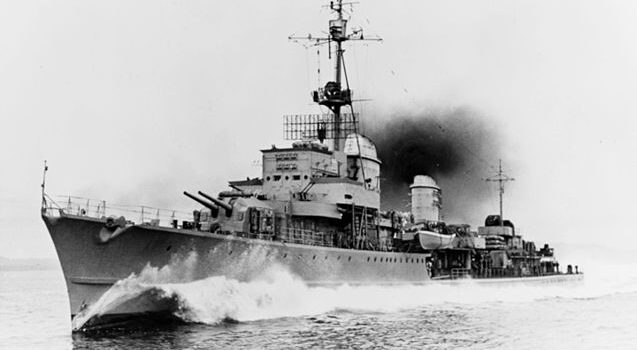



 Latest Facebook Entry -
Latest Facebook Entry -  X(Tweeter) Naval Encyclopedia's deck archive
X(Tweeter) Naval Encyclopedia's deck archive Instagram (@navalencyc)
Instagram (@navalencyc)





 French Navy
French Navy Royal Navy
Royal Navy Russian Navy
Russian Navy Armada Espanola
Armada Espanola Austrian Navy
Austrian Navy K.u.K. Kriegsmarine
K.u.K. Kriegsmarine Dansk Marine
Dansk Marine Nautiko Hellenon
Nautiko Hellenon Koninklije Marine 1870
Koninklije Marine 1870 Marinha do Brasil
Marinha do Brasil Osmanlı Donanması
Osmanlı Donanması Marina Do Peru
Marina Do Peru Marinha do Portugal
Marinha do Portugal Regia Marina 1870
Regia Marina 1870 Nihhon Kaigun 1870
Nihhon Kaigun 1870 Preußische Marine 1870
Preußische Marine 1870 Russkiy Flot 1870
Russkiy Flot 1870 Svenska marinen
Svenska marinen Søværnet
Søværnet Union Navy
Union Navy Confederate Navy
Confederate Navy Armada de Argentina
Armada de Argentina Imperial Chinese Navy
Imperial Chinese Navy Marinha do Portugal
Marinha do Portugal Mexico
Mexico Kaiserliche Marine
Kaiserliche Marine 1898 US Navy
1898 US Navy Sovietskiy Flot
Sovietskiy Flot Royal Canadian Navy
Royal Canadian Navy Royal Australian Navy
Royal Australian Navy RNZN Fleet
RNZN Fleet Chinese Navy 1937
Chinese Navy 1937 Kriegsmarine
Kriegsmarine Chilean Navy
Chilean Navy Danish Navy
Danish Navy Finnish Navy
Finnish Navy Hellenic Navy
Hellenic Navy Polish Navy
Polish Navy Romanian Navy
Romanian Navy Turkish Navy
Turkish Navy Royal Yugoslav Navy
Royal Yugoslav Navy Royal Thai Navy
Royal Thai Navy Minor Navies
Minor Navies Albania
Albania Austria
Austria Belgium
Belgium Columbia
Columbia Costa Rica
Costa Rica Cuba
Cuba Czechoslovakia
Czechoslovakia Dominican Republic
Dominican Republic Haiti
Haiti Hungary
Hungary Honduras
Honduras Estonia
Estonia Iceland
Iceland Eire
Eire Equador
Equador Iran
Iran Iraq
Iraq Latvia
Latvia Liberia
Liberia Lithuania
Lithuania Mandchukuo
Mandchukuo Morocco
Morocco Nicaragua
Nicaragua Persia
Persia San Salvador
San Salvador Sarawak
Sarawak Uruguay
Uruguay Venezuela
Venezuela Zanzibar
Zanzibar Warsaw Pact Navies
Warsaw Pact Navies Bulgaria
Bulgaria Hungary
Hungary

 Bundesmarine
Bundesmarine Dutch Navy
Dutch Navy Hellenic Navy
Hellenic Navy Marina Militare
Marina Militare Yugoslav Navy
Yugoslav Navy Chinese Navy
Chinese Navy Indian Navy
Indian Navy Indonesian Navy
Indonesian Navy JMSDF
JMSDF North Korean Navy
North Korean Navy Pakistani Navy
Pakistani Navy Philippines Navy
Philippines Navy ROKN
ROKN Rep. of Singapore Navy
Rep. of Singapore Navy Taiwanese Navy
Taiwanese Navy IDF Navy
IDF Navy Saudi Navy
Saudi Navy Royal New Zealand Navy
Royal New Zealand Navy Egyptian Navy
Egyptian Navy South African Navy
South African Navy






























 Ukrainian Navy
Ukrainian Navy dbodesign
dbodesign